DEATH AND BURIAL
Descriptions and processed field notes
1. INTRODUCTION: ON RESEARCH INTO RITUALS OF DEATH
When I first began collecting material for my PhD thesis on the ‘Rites of Passage of the Bulsa’ in 1972–74, I ascertained that I should expect strong resistance and restrictions when researching death and burials. The funeral celebrations (Kumsa and Juka) – more accessible to strangers among these rites – initially seemed somewhat chaotic to me in their sequence of events; the meaning of individual rituals was often difficult to discern. A longer, multi-year residency would have been necessary for intensive, successful research. Therefore, I discontinued my in-depth exploration of this topic, and even in the publication of my PhD thesis (1978). The description and analysis of this pivotal rite of passage are absent.
In subsequent research visits to Bulsaland (in 1978, 1981, 1984, 1986, 1988–89, 1994, 1997, 2001, 2002–3, 2005, 2006, 2008, 2011, and 2012), other topics were the primary focus of my fieldwork, such as ancestor worship, divination, material culture, the Mungo cult, the earth cult, and the history of the Bulsa. Only after gaining trust and a great openness to information from all the inhabitants of a particular compound (Anyenangdu Yeri, Wiaga Badomsa), especially its head (yeri nyono), Anamogsi – through my repeated visits was I able to venture into the challenging exploration of the rituals and attitudes associated with the most painful crisis of life.
Death is an event that shocks close relatives of the deceased to such an extent that outside observers are often unwelcome. At first, when I asked a family I knew for permission to attend a burial, I either received a clear refusal or it was explained to me that the burial had already been conducted in the dark of night. It is thus unsurprising that, throughout my fieldwork among the Bulsa over 40 years, my access to the only three burials where I was able to observe all rituals completely and document via photographs was enabled in some way by Anamogsi, the compound head (yeri nyono), earth priest (teng-nyono) and elder (kpagi).
The burial of his granddaughter Akanchainfiik, who had died in infancy, was held in front of Anyenangdu Yeri. In Wiaga-Yisobsa, the burial of Anamogsi’s great-granddaughter Asiuklie was also made possible for me to witness by Anamogsi’s grandson, Yaw (my assistant and Asiuklie’s father). My attendance at the posthumous ‘burial’ (ngarika) of a man who had died abroad was only possible because Anamogsi, as an elder (kpagi) of the lineage segment of the relevant compound, was a respected co-organiser of the burial, meaning we did not need permission from the head of the deceased’s house.
In contrast to burials held in the immediate family circle, funeral celebrations (Kumsa and Juka), generally occurring only in the next dry season (or even years later), are much more of a public affair. The elders in the kusung-dok (the closed meeting room in front of the compound) usually do not refuse permission to a stranger to attend the ritual after he has greeted them with a bottle of akpeteshi (palm brandy). If reservations are expressed about a European’s participation, they usually come from younger participants with school education. I experienced such opposition twice in Wiaga, but it was fended off vehemently by the elders. In Wiaga-Mutuensa, the older men even let me come to them, bought me a drink, and emphasised that I was still very welcome at this celebration. In Wiaga-Chantiinsa, one son of the deceased who otherwise resided in southern Ghana raised objections to my participation, but the elders immediately rebuffed him.
In all other instances, I was met with a sympathetic welcome. In Wiaga-Guuta, after the welcome finished, the organiser (yeri nyono?) came to me and said that this was typically a smaller funeral celebration. However, because of my visit, it would be considered a large and significant one.
No general rules are set for photographing individual rituals. Most of the time, I asked during the greeting about which rituals and other activities would have photography desired or prohibited. The answer was usually the same: I could take pictures of everything, but pictures of the widows in their foliage costumes, especially when taking a bath, were not desired. This prohibition is likely less due to religious reasons than general human feelings of propriety and shame.
While visiting a funeral celebration in Gbedema, I was barred from observing all activities of the celebration by a young man with a good command of English, although I did not know whether this behaviour originated from him personally or if he had been instructed to do so by an official body. Although the former assumption was correct, I left the funeral without observing anything significant. Reports of this incident spread around Gbedema and caused great displeasure among some influential personalities about the young person’s behaviour. Even the chief sent his apologies to me.
Despite promises of free observation and photographic documentation, efforts to observe the celebration may occasionally be hampered by individuals or groups of people (e.g. the gravediggers). I noticed such obstructions several times during the two funeral celebrations documented in Sandema; I hardly experienced them in Wiaga. This may be because I am better known in Wiaga and have long been regarded as ‘Anamogsi Felika’ (Anamogsi’s white man). In Wiaga-Kalijiisa-Choabisa, I was taken to a neighbour’s house before the performance of the nang-foba rites (involving the killing of two cows). After photographing the mat burning, I was insulted by a drunken man. At the funeral celebration of Awuliimba (1989), the father of my (and Prof. Schott’s) long-time friend, Rev. James Agalic, we were promised unrestricted freedom of movement at the beginning. However, the gravediggers later forbade us from taking photos of the granary’s dressing, the donkey’s killing, and so on.
Even disregarding problems from some actors or participants, documenting a funeral celebration is difficult, mainly due to the various settings in which one may occur. In funerals for deceased women and men, most of the rites for the women occur behind the compound, while those for men do so in front of it. At this time, the older men in the kusung-dok can deliberate on important issues for which it is worth turning on the tape as other important rites are being prepared inside the compound. In these settings, working with only one camera and without at least one capable assistant who understands Buli well and knows how to handle a camera inevitably leads to imperfect results.
One problem in summarising all my documentation was that although I attended a relatively large number of funerals, I was only able to observe and document a few in their completeness over four days (see list of all funerals attended, Appendix No. 5.6). As already indicated above, my schedule is mainly responsible for this, according to which I often prioritised attending other events. In addition, I did not know some of the compounds visited very well beforehand, so I was not entirely familiar with the social and genealogical status of many people involved.
Surprisingly, the funeral celebration I did not attend was the best documented by interviews with the participants and photographs: The 1991 funeral of Anamogsi’s father, Anyenangdu, where my German friend Martin Striewisch was able to take photos and gather information without hindrance, and my co-worker Danlardy Leander (also of Wiaga-Badomsa) was able to record important rituals with his camera – even those performed at night. Perhaps more crucially, in my subsequent stays, I was able to gather any information I needed about these death rituals from my friend, Anamogsi, by analysing photographs from 1991.
2 DEATH
(Ku-yogsik or ku-palik, ‘fresh’ or ‘new death’)
2.1 The positive evaluation of earthly life
For the Bulsa people, the death of a close relation is an event that triggers horror and intense pain and confronts the individual with events and thoughts that were, before the event, mostly repressed from everyday life. Associations with death or funerals are avoided as much as possible in daily life or are taboo. For example, singing funeral dirges (kum yiila; singular kum yiili) or mixing beans (tue) and round beans (suma) before cooking together, as is done for a dish on the third day of the Kumsa funeral celebration, is forbidden outside funerary settings. People also like to use euphemistic-sounding phrases when discussing death and dying [endnote 1], such as:
O vuusi: He has breathed (his last breath).
Wa duag, wa ngmain yiti-a: He is lying; he does not get up (any more).
Wa noai ale niigi: His mouth is tired (fed up, sick).
Wa tong ka nang: He shot into his leg, meaning ‘He struggled before death’.
Wa taam ka nna diing: He has passed away peacefully.
Wa tog ka buketik: He kicked a bucket.
Fi liewa bo doku po: Your daughter is in the room (when announcing the death of a woman to relatives).
O basi teng zuk: He has left earth.
Wa sing ka kpilung: He descended into the realm of the dead.
Wa cheng ka ti koma tengka: He has gone to the land of our fathers. Wa diag o koba nisima: He shakes (shook) hands with his fathers (ancestors).
Wa siek ka ngaasa: He agrees with the ancestors.
In addition, for the death of a child, the typical word for ‘die’ (kpi) is not used, but ngmain (‘return’, i.e. the child returns in a rebirth).
Life in a ‘different world’ – the realm of the dead (kpilung) [endnote 2] – is similar to life on earth in many ways. The dead live in compounds with families and further kinship groups, but this different life is not necessarily enticing.
This notion is expressed, for example, in a Buli idiom that appears in various linguistic versions. An informant from Gbedema knows the following phrase:
Taa jo ka yaba teng zuk, kpilung ka ti miena teng.
We are enjoying the market on earth; the land of the dead is the village (or land) of us all.
The following version was provided in Wiaga:
Ti bo ka yaba, yabanga dan nueri ti te kuli.
We live in the market; when the market closes, we leave.
In S.A. Ekundayo (1977: 62), I found almost the same formulation with the same content in a Yoruba sentence name:
The world is a marketplace, but heaven is the home; we are strangers on earth; heaven is our home.
In all versions of this saying, earthly life is associated with a market. At the market (yaba), which occurs every three days, surplus agricultural products are sold, and goods not produced in the compound are bought. This marketplace is associated with a variety of pleasures and social contacts. These can start with the enjoyment of a bowl of pito (daam) in the company of friends and extend to the efforts of young people to find a suitable marriage partner (especially since such a search is excluded in one’s section or lineage among relatives).
If earthly life, when likened to the bustle of the market, is so appreciated by the Bulsa, it is unsurprising that the longing for death and the desire for a better life in the hereafter seem to have little place among the Bulsa. When the colourful market activities of earthly life end, the long period of ‘everyday life’ in the hereafter begins for them.
2.2 Causes of death
Any death can be classified as natural or unnatural, depending on the results of a divination session. People of advanced age who have been ailing for a long time usually die a natural death. In such cases, a natural death can be expressed by remarks that God (Naawen) has taken the deceased. For deceased younger people who were generally considered healthy and strong in life, one almost always seeks a supernatural cause in their immediate surroundings. Some examples of this scenario are given below.
(Information provided by Yaw Akumasi, fn 08,1a): When Anamogsi’s wife, Akumlie, fell ill, a diviner found out as the reason for her illness that her Christian son had thrown away her juik (skin). When Asuebisa retrieved it after an initial refusal, it was already too late, and Akumlie died.
Reporting on the death of his father, Danlardy Leander (fn 88,167b) said that his father slaughtered a black cock (at the tanggbain?) on the advice of an elder classificatory brother from another compound and uttered particular wishes which were not agreed to by the spirit. This led to his death. A diviner found that Leander would suffer great pain in the afterlife. The successor of the ‘elder brother’ wanted to slaughter a black cock again to undo his fatal advice, but persons from Leander’s family and others were afraid.
My first assistant, Godfrey Achaw (fn 55a), reports that ancestors kill very slowly, and teng and tanggbain do so very suddenly. If death comes gradually, the dead person receives a funeral celebration; if it comes suddenly, none. In the latter case, the death mat is burnt on the day of death, and the person is buried outside the house.
Murder is considered a very extraordinary and terrifying kind of death (fn 73,54a, G. Achaw). Although the execution of revenge is not (and was not) required before the usual burial of a murderer, the family of the murderer and the victim will since be considered enemies; in other words, they are not allowed to eat together or marry among each other. In one case, a man killed his runaway wife with an axe. The murderer had to undergo purification rituals but not make any payments. The traditional punishment for a murderer was that everyone shunned him, including his brothers, and he was not allowed to ask anyone for anything. Often, this led to his suicide. After his death, he is given an ordinary funeral celebration because otherwise, it would not be possible to hold celebrations for other members of his family who die later.
2.3 Kum-biok, the evil death
Certain external circumstances make someone’s death a kum-biok or ‘evil death’ (a synonym is kum-toak – ‘a bitter death’; a normal death is called kum-weeling).
Dying outside a compound without the presence of close relatives is considered shameful and is regarded as kum-biok. The types of death listed below are particularly associated with kum-biok (main informant Yaw Akumasi, fn 01,14b).
Opinions differ on whether a person who dies of a kum-biok can become an ancestor. While James Agalic from Sandema writes in his M.A. thesis that a person who has committed suicide, witchcraft or adultery, for example, also becomes an ancestor, E. Atuick (2020: 36) from Wiaga holds the following view: ‘…people who die through accidents, premature or sudden death, leprosy, witchcraft, etc. are never regarded as ancestors…’
2.3.1 Death during hunting accidents
In the past, kum-biok frequently occurred in fatal hunting accidents or war campaigns, and now also in fatal road accidents, after which no relative can hold the head of the dying person.
2.3.2 Death outside the compound
(case:) The death of a young man who wanted to spend the night in the kusung (a wall-less meeting room) in front of the compound and was surprised by death there is also given this derogatory name.
2.3.3 Death during pregnancy
The death of a pregnant woman is still considered reprehensible today. The embryo is removed from the dead woman by gravediggers by pressing the abdomen and then buried separately. The woman is buried against the outer wall of a guuk (an abandoned compound). She is always to blame for her and her embryo’s death because, allegedly, she did not want to keep the child (Yaw, fn 97,10a, Anamogsi, fn 02,16a).
2.3.4 Death of a leper
According to Danlardy Leander and Yaw, the death of a leper is also a kum-biok because it is a strict taboo to hold the head of a dying leper. Often, only his children are present at his death, and after his death, he is sprinkled with water using a leaf branch of the gaab tree [Diospyros mespiliformis]. Specialists are then consulted to deal with the death of someone who has died of leprosy (ning doma), and they perform rituals similar to those described below for death by lightning. The body of a leprous man with children is carried out of the compound through the main entrance, and that of a childless woman is over the back wall. If this height is too high to carry the body over, a piece can be knocked out (down to the ground). Lepers can only be buried by an old, experienced gravedigger (vayiak kpak).
The funeral celebration of a leper must not be held together with that of other deceased persons. In dark Buli [Buli soblik], a leper is called bolim (fire).
2.3.5 Dying from a curse
Curses can have evil consequences for the curse-giver and the cursed. At many tanggbana (earth shrines), a curse is considered an explicit taboo for all who sacrifice at that earth shrine. A curse is often not recognised as such by outsiders. The curser, for example, only says to another that he has to blame himself for the evil consequences of his actions. Or he leaves it up to a supernatural being at its shrine what should happen to the hostile person.
(Yaw, fn 11,8b): Anamogsi’s eldest son, As., did not want his son, Ak., to go to the south of Ghana. Before the trip, Anamogsi’s grandson had uttered a curse against his father, which neither of them had taken very seriously: ‘If I am going and if something happens to you, it is your own [fault]. If you do not mind, I am no longer your son’. Afterwards, As. visited his son in the south, and the latter bought his father a new bicycle and gave him money. But it was too late – a month after the visit, Ak died. A diviner confirmed that he had died because of the curse. As. then went south ‘to fetch the funeral’—he fetched some earth from Ak.’s grave in a cloth to be buried later in Bulsaland (see ngarika, Chapter 3,8). On his return, As. was waiting at the Alonggaab (Sichaasa-tanggbain). However, his father, Anamogsi, would not come to fetch him until the curse was withdrawn (he was also upset that As. had not given him notice of his journey to the south). Anyik (Atinang Yeri) and others persuaded Anamogsi to pick up his son. The earth was buried in the cattle yard. It has been doubted whether Ak.’s death was a kum-biok.
(Alice Bawa Ani, fn 81,1a): A woman of her house in Gbedema was doglie in Fumbisi and married there. Her husband neglected her and her child and did not attend funeral celebrations in Gbedema. When the woman became thinner and thinner from giving all the food to her child, her father ordered her to return home. When she disagreed, her father probably pronounced some curse on her deathbed and called her to him after his death, as a diviner discovered.
2.3.6 Suicide
Suicides in ancient society were mainly of the following three types (fn M53a):
1. Nag zuk, to bang one’s head against a hard wall or rock
2. Lu pein, to stab oneself with a poisoned arrow (it can also be a fishhook)
3. Bob miik, to hang oneself (this expression is also used when the manner of death is not known)
Self-chosen death (suicide) was likely rare in ancient society and was generally regarded as a shameful act that required atonement and neutralisation through extensive rituals. A large proportion of the suicide instances that I know of happened in the circle of the relatively more educated generation of the Bulsa – people who could not cope with the heightened tension between the old and new society or who had become fixed on their failures in school education or professional pursuits.
Relatively common are suicides by people who have been touched by a ghost (kok) and expect a soon-to-come and agonising death (examples in Chapter 6.2., Ghosts).
(Information from Margaret, 1978ff, fn M8a): One night a relative tried to hang himself from a dawa-dawa tree near the compound. When the rotten branch broke, he screamed for help. Apart from a broken leg, he was not seriously injured. The reason for his attempted suicide was that he wanted to join his ancestors. Margaret’s father said that one should not hinder a suicide, but he feared that he would be reproached. It was also rumoured that witches drove the relative to think of suicide.
In Gbedema, a man killed himself by injuring several parts of his body with poisoned fishhooks.
After trying to cut his throat with a blunt knife, he only injured himself and screamed for help.
2.3.7 The swollen body (nying fuusika) of the deceased as a sign of kum-biok
When a young woman (name and home known) died in Wiaga, her arms, legs, and abdomen were swollen. The swellings occurred after she left her husband who was supposed to have caused the swelling. More than 10 gravediggers were called for the burial. As is customary for women, the deceased was buried outside the traditional compound with the other women but a little away from them. The gravediggers and all those who had touched the deceased participated in the vaam-soka bath (see below), which was performed afterwards. Each bather gave a chicken and occasionally some millet flour to the head of the gravediggers.
2.3.8 Lightning
(Information from Yaw, fn 97,10a) A kum-biok by lightning (ngmaruk or ngmoruk) means that God (Naawen) has killed the person; therefore, his death mat must not be hung in the same room as those of previously deceased persons. After death, ritual specialists (ngmaruk-bisa) from Angmaruk Yeri (Wiaga-Yimonsa) come to the compound concerned. No one else is allowed to touch the dead person, and all inhabitants who were outside the compound at the time of death are not allowed to enter it until the Yimonsa men arrive. They come with water and certain herbs and, with the help of a broom, sprinkle (miisi) the dead person and his room and then walk once around the compound. All movable things they sprinkle belong to them afterwards, such as clothes, sandals, or a bench. They also sprinkle the corpse with their herbal water before burying the body. A person killed by lightning may be mourned only a little.
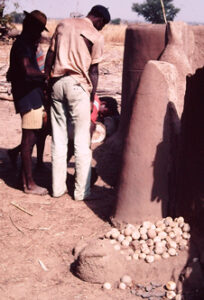
Stockpile of tintankori-stones in Asebkame Yeri
(Information corroborated by observations in Asebkame Yeri, Chiok, fn 88,121a) The compound owns a medicine that combats thunder and lightning. If a tree is struck by lightning, no one may touch it until the ngmaruk medicine has been sprinkled on it, and a person killed by lightning may not be buried without someone applying the medicine to the deceased. When the specialists go to an affected or strange house, they give its inhabitants a round stone (perhaps as part of the medicine?). Asebkame Yeri has a pile of round stones (tintankoa) to the right of the main entrance; it is a stockpile of stones collected from a river.
2.4 Occurrence of death
If a Bulsa man is afflicted with a serious illness that is suspected of leading to his death, the following measures may be taken:
2.4.1 A diviner (baano) should discover the illness’s spiritual origin. Has the sick individual sinned against the ancestors or other divine powers? Has he broken major taboos or omitted essential duties? Through appropriate sacrifices, they can try to change the course of events.
2.4.2 The medicine man (tebroa or tiim-nyono) is consulted for advice and therapeutic remedies. For example, he may prescribe using root extracts or charred plant parts or inhaling certain vapours or smoke. His prescriptions may contain religious–magical elements (e.g. procuring a root at a specific time of day at a given place). However, according to modern medical knowledge, some of his prescribed medicines may also have healing effects.
2.4.3 If the therapies above do not help, people may visit a clinic or hospital as a last resort. Today, this step is often combined with the healing practices mentioned above.
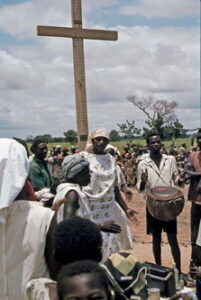
Meeting of a charismatic movement in Sandema
2.4.4 Healing through charismatic people: In recent decades, some charismatic Christian movements have promised the ability to heal almost all diseases [endnote 3]. The leaders and their helpers pray for the patient, give behavioural instructions, and administer healing water. Such faith healers are visited by followers of almost all Christian denominations and, to a large extent, by members of the traditional religion.
2.4.5 If all remedies and therapies prove ineffective while the condition of a terminally ill person continues to deteriorate, arrangements are made for their expected death. These include that a dying person living in a more modern house in the centre of a village is taken by family members to the individual’s ancestral paternal compound at night. In anticipation of their death, the dying often advocate for this transport themselves. Married women, for example, want to die in their husband’s house (not in their parents’ house).
2.4.6 In a chosen room (dok; often, it is the dayiik) of the traditional compound, the dead person is laid on a mat, which will later play a significant role as the person’s death mat. Some older women are constantly near the corpse. They try to comfort him verbally (saying, e.g. Naawen te fu nyingyogsa, i.e. ‘God give you health’).
(Margaret, fn M60a) They may sprinkle water on a sick person’s body or administer more medicine to relieve pain. Most importantly, they must hold his head and upper body up so the sick individual is almost sitting.
(Margaret 1978ff, fn M60a): When an old man in Gbedema died, many visitors said, ‘Naawen te fu nyingyogsa’. In response, the dying man said, ‘Aba, Naawen yeng ka le la’. (‘That’s enough! This is the same God!’ or ‘There is only one God’). He continued, ‘Wa nya Ama. Fumbisi abe wa jam nya mi Gbedem ale ku baasa nying la’ (‘He should see [the dying] Ama in Fumbisi and then come and see me in Gbedema so that I will feel better’), meaning ‘God is not everywhere and cannot help Ama and him at the same time’.
(Yaw, fn 02,36a) In Wiaga-Chiok, when a man of about 70 was dying, his juik skin, a visible object of a spirit connected to the mongoose [endnote 4], was placed around his neck. By doing this, he said goodbye to a spirit that was exclusively connected to himself. Only certain people were allowed to remove it after his death and display it outside on a stick until it rotted [endnote 5].
2.4.7 Determination of death: If a person’s death is noticed due to, for example, the cessation of breathing, the death can be checked by other measures. These include listening to the heartbeat or holding a mirror in front of the dead person’s open mouth, perhaps to perceive minute respiratory currents.
2.5 Kuub darika, the announcement of death
After someone’s death, their close relatives are filled with deep pain. However, those mourning are not allowed to show this to the outside world until after the official announcement (kuub darika) of the death and the digging of the grave has begun.
2.5.1 Reasons for postponement
While the kuub darika is usually performed immediately after death, there are reasons for postponing it, as some examples will show:
– A kuub darika could not be performed in Badomsa because a wife of the deceased was still staying in Accra (fn 2011,8a).
– (fn 2011,8a) After an old man’s death, it was suspected that one of his wives had committed unpunished adultery. This woman, however, refused to undergo the kabong-fobka ritual, where a white chicken – which incurs the guilt of the accused – is brushed over the human body and then killed by beating it on the ground [endnote 6]; the kabong-fobka ritual, performed properly, allows a diviner to determine that the death can be announced.
– (fn 94,17b) When an old diviner (baano) and compound head (yeri nyono) died in 1994, his death was not allowed to be announced because he had skipped the kuub darika after his father’s death. He was immediately buried ‘like a toddler without any subsequent siblings’, including no mourning. Even in 2007, his death’s announcement had not yet happened. If subsequent rites and amends do not clarify the matter, all the diviner’s children will be buried without the kuub darika ritual.
– (Information from Danlardy Leander) Reasons for postponing the kuub darika include that a severe illness afflicts many in the compound or that there is a major dispute. If another person dies shortly after the death, the second death cannot be announced until the kuub darika of the first person has been completed.
2.5.2 Performance of the kuub darika
The announcement often begins with initial information given to the nearest relatives living outside their compound (ko-bisa; literally, ‘children of one father’) in the order of seniority. They are also invited to the mourning compound [endnote 7]. After the ko-bisa, more distant relatives are informed, but they are only told that NN has died; further details of the death are not provided.
Sons-in-law of the deceased usually receive the death news through their san-yigma. This man is related to both the son-in-law and the father-in-law (i.e. matrilineally) and played an intermediary role in bringing about the marriage (cf. Kröger 1978: 274–75).
An informant of mine, Ayomo (fn 81,47b), was the sanyigmo of Atanla’s wife (Abapik Yeri), who came from Sandema-Abilyeri, like Ayomo’s mother. When Atanla’s wife died, Ayomo was tasked with providing a hoe and a chicken as gifts to announce her death at her parents’ house in Abilyeri. Ayomo also played a significant role in her funeral celebration.
Invitations to a funeral or a mourning visit can also be declined. After Yaw and I brought the body of Yaw’s sister to Apok Yeri, her traditional parental home, we were asked to visit far-flung compounds of relatives on our bicycles as part of the official announcement (kuub darika) and issue invitations for the burial. An old head of a compound, Yaw’s grandfather (MF) – who would have liked to conduct the funeral – declined the invitation because Yaw and his mother had not accepted his invitation to his father’s death rituals.
(fn 94,91a) Upon the death of Danlardy’s stepmother, Maami, her family first informed the ko-bisa and the other compounds of Danlardy’s lineage (Adiok Yeri, Abakiak, etc.). They all came to the compound of Danlardy’s father (Leander) and informed the stepmother’s san-yigma. He then informed the chief’s house (the deceased’s parental compound), though its inhabitants had long since heard of the woman’s death [endnote 8]. (fn 01,8a) Shortly thereafter, people from the chief’s compound came to Asik Yeri (Badomsa) to inquire about the ‘weariness’ (jianta) of the residents [endnote 9]. They received drinks there; Danlardy and his classificatory siblings – Michael, Tenni, Francis, Oldman, Ayomo, and Atongka – and his mothers and others also gave money. After about one week, some residents of Asik Yeri (including Ayomo, Atongka, Kenkenni, the mothers and others) returned to the chief’s compound. They were given millet water and alcoholic drinks; old men and others also gave money, though they would not have given it if they had not received money in Asik Yeri. They gifted so much akpeteshi that Danlardy’s relatives could not drink it all and took half a bottle home. Danlardy calls this exchange of gifts ‘siinika’ (cf. chapter 4.2.4.2.: distribution of gifts at the Kumsa funeral celebration).
(Yaw, fn 01,11b): When a wife dies in her parental compound (e.g. during a visit), her husband or son sends a nakogla bangle along with tobacco, kola nuts, and alcoholic beverages for a libation to her parental compound. The in-laws can keep the bangle if the funeral celebration is held at the husband’s compound. This practice is still carried out today.
2.6 Notification of the earth priest (teng-nyono)
Notifying the earth priest (teng-nyono) of the death is often necessary. In the interviews with the 41 earth priests of Wiaga, I ensured to ask whether the bereaved must seek permission to bury a deceased person. The earth priests of, for example, Guuta, Zuedema, Bachinsa, Kubelinsa, Longsa, Dogbilinsa, Yisobsa-Yipaala, Bandem and Farinsa must give this permission. The earth priests from other sections said they only required information about the death. If the deceased was a witch (sakpak) [endnote 10] or was killed by the tanggbain of their earth priest, the relatives have to provide the tanggbain with a ‘mammal’ (dung), which must be a bovine in many cases (e.g. the tanggbana of Bachinsa, Kubelinsa, and Bandem). In general terms, Adama (from Chiok) explained that a cow must be given to a teng-nyono if the deceased was killed by his tanggbain.
If earth priests must give permission for the burial, it must also be sought before a Kumsa and Juka funeral celebration. Some earth priests stated (without my asking) that they would attend the funeral if possible.
2.7 Mourning and mourning visits
Before the kuub darika and the grave digging begin, no mourning visits or expressions of grief may occur. Even close relatives must withhold their grief until then. For safety, one inhabitant of the compound is sometimes sent to the compound’s main access road to prevent loud lamentations from arriving guests.
After the death announcement, expressions of mourning by the compound’s inhabitants begin, and relatives or friends from other villages visit the compound for this purpose (Achaw, fn 73,45). Even if daughters are married in faraway compounds within Bulsaland, they must come on this specific day. Today, this is made possible by bicycle or car travel. Before a daughter of the dead leaves her husband’s house, a long fibre rope is tied around her left arm. She is held by it if she wants to run too fast to her deceased father’s house; the rope is also said to prevent the daughter from committing suicide. More distant relatives can mourn on their way but only utter loud cries when they are a few hundred metres from the house. When a father dies, a son must always be accompanied by someone from his age group (even when he goes to the toilet) ‘to prevent a suicide’.
The extent to which a person is personally affected by the death does not influence the kind and course of the mourning rites. Mourners arriving from outside might not show any signs of distress; they perhaps even joke among themselves 50 metres from the compound. As they approach the compound, however, they begin to cry loudly and utter ‘Waa-soi’ or other cries of grief in tears.
A mourning man is supported (chogsi) by another man (chogsoroa or yigdoa) as he walks, and a mourning woman by at least two other women – sometimes by additional female companions (Inf. Yaw, fn 2006,35a).
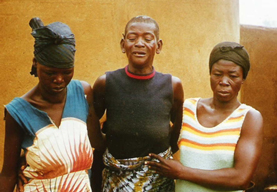
Mourning in Wiaga-Bachinsa
Female mourning groups proceed all the way to the dalong with the laid-out dead person (later, his death mat); conversely, men usually only walk a few steps through the main entrance (nansiung) into the cattle yard (nangkpieng) and from there, back to the rubbish heap (tampoi) in front of the compound. Such a funeral procession may be performed several times. At the tampoi, a woman or child hands the mourners a calabash of clear water for washing their faces. Afterwards, when the mourning ritual is over, people may laugh again.
There is no prescribed time limit for mourning visits. Mourners may still arrive many years after a death. Non-relative friends of the deceased should come after the burial because they might die should they see the body – they are in constant danger of being taken into the afterlife by their dead friend. After the death of my first helper and friend, Leander Amoak, and after the death of Anamogsi, my friend and chief informant, my Bulsa informants even feared danger to me if I came to see their grave years later [which happened anyway].
(fn 02/03,32b, Information from Yaw) After the death of a young man, one of his former friends said that she wanted to die with him. Immediately a ritual of ‘undoing’ (piirika) had to be performed. The young woman thereby said: ‘Mi le biisa di la, di la le nna, ate n pursi bas’ (literally: ‘What I have said, it is this, that I spit it out’. Freely translated, it means: ‘I hereby take back my statement’). Afterwards, the woman was rubbed with ashes from the hearth or tampoi so that the dead person would not be able to recognise her.
Mourning visits by distant relatives or Europeans have a different character, especially when they occur after the burial rites have been completed. In English, the Bulsa use ‘sympathising’ (Buli: yika) rather than ‘mourning’ (kumsa) to describe such visits.
In 1981 (fn 81,14b), Leander Amoak and I visited Azubak Yeri in Bachinsa to mourn. When we approached the compound, my companion suddenly began crying loudly and shouting (‘waa-soi’ or ‘yaa-soi’). A small boy came out of the compound to support him. Leander went to the courtyard where the mat was already hung up, then to the ash heap (tampoi), back to the mat, and finally to the kusung. A small boy brought him a large calabash bowl with clear water for washing his eyes. After that, they were allowed to laugh again.
(Information from Yaw, fn 06,35a): My co-worker Yaw was in southern Ghana when the compound head and his (classificatory) father-in-law, Aluesa, died. Therefore, a delegation from Yaw’s Wiaga compound, Apok Yeri, went to the home of the late Aluesa in Wiaga-Sichaasa without him. Yaw did not need to make up the visit, but even if the group from Apok Yeri had not gone to Sichaasa, he would not have done so as a Christian. Later, Yaw’s wife, Tenni, went with the Ama (the senior wife of the compound) and other women from Apok Yeri to Sichaasa to the Amadok (the first wife’s court) to mourn. There, she also greeted the other women of Anduesa Yeri and its neighbouring compounds, giving them kola nuts and drinks for their services to her classificatory father. She then went to the men in the kusung and gave them alcoholic drinks for enduring the cold (ngoota) during the burial. Several shots were fired to indicate to the neighbours that a child of the dead man had come. If Tenni had not paid a funeral visit, she would not have been allowed to mourn after the death of her biological father.
Mourning experience of the author in Anyenangdu Yeri:
A European who was friends with deceased Bulsa is not expected to perform the Bulsa mourning rites in detail and start crying loudly before he reaches the compound. However, a funeral visit is necessary for him to maintain his friendship with the compound. The English word ‘sympathising’ is often used for this mourning visit.
After my 2005 stay at Anyenangdu Yeri, its headman (yeri nyono), Anamogsi passed away. When I returned to the compound in 2006, I was expected to make some official expressions of mourning (fn 2006,1a; fn 2011,1a).
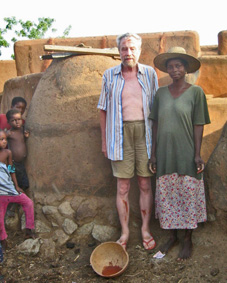
The author painted with red earth
First, I visited the men in the kusung. Although I had seen and greeted them before, an official greeting still had to occur. Before drinking, I and everyone present offered a libation of my donated akpeteshi (palm brandy) by pouring some brandy on the ground. After this, I went with my helper, Yaw, to the courtyard of the deceased’s eldest wife. Here, too, we and others drank from the alcoholic beverage we had brought with us. This time, however, the libations were omitted. I was only allowed to see the grave after completing this sequence of events [endnote 11].
A similar process of ‘sympathising’ had already happened in 2005, after my long-time cook Agoalie – one of Anamogsi’s wives – had died before I arrived in Ghana. One day after the mourning rites, as described above for Anamogsi, I was taken to the compound’s cattle yard. At the entrance to Agoalie’s living quarters stood Ajadoklie, a daughter-in-law of Anamogsi. She had played the impersonator (che-lie) role at Agoalie’s funeral and was now wearing Agoalie’s straw hat. She held a calabash with red daluk earth mixed in water in her hand. I was painted red by her on the following parts of my body:
1. Vertical lines on both shins,
2. Strokes on the forearms,
3. And a horizontal line on my forehead.
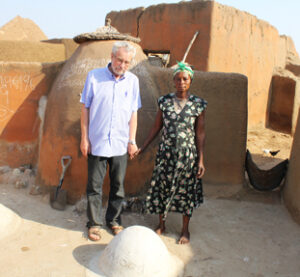
Only after the mourning ritual I was allowed to see Anamogsi’s grave.
Ajadoklie explained that had I been able to attend the funeral, I would have been painted the same way. I presented a monetary gift to Ajadoklie to compensate her for her services as an impersonator of Agoalie.
2.8 Mat gifts at the burial visits and later
Immediately following the death of a person up to the Juka funeral service, tiak sleeping mats are more or less officially given to the house in mourning by married-out daughters and sons-in-law. The somewhat confusing information about mat gifts to the house of mourning shall be compiled here for clarity.
2.8.1 Gifts at funeral visits before the death celebrations
(Information from Danlardy, fn 88,305a) Before the funeral of a married woman, the brothers of the dead – men from her birth section – come to the house of mourning (i.e. her husband’s section) with a mat (tiak). This mat initially remains in the cattle yard; the death mat remains in the dabiak (inner courtyard). Later, the mat from the birth section is placed in the bedroom of the dead with a new calabash. When daughters of the dead come to their parents’ house, they are supposed to sleep on it and drink from the calabash. However, this is no longer done by everyone today.
According to other information, the death mat is exchanged for the donated mat later, but before the ta-pili yika ritual, as the former mat becomes dangerous due to contact with the dead and the smell of corpses (piisim). One will destroy the original death mat later by, for example, throwing it into a river.
(From a letter of Danlardy, fn 97,63a): The mat on which the dead passed away can be wrapped around a donated mat – the lie kuub puusa mat [‘the daughter greeting death‘ mat] – and then hung in the kpilima dok. At the Kumsa funeral, the lie kuub puusa mat is burnt along with the death mat.
Observation in Wiaga-Goansa (fn 97,47a): In the centre of Wiaga (near Leander’s residence), I observed a group with a mat from Wiaga-Farinsa (Akanko Yeri), the childhood home of Leander’s wife, Atoalinpok. Their musical accompaniment consisted of two gungong drums, one gori drum, and three flutes (wiisa). They had only made their funeral visit to Asik Yeri now, four years after Atoalinpok’s death, because there had been problems at their compound. They performed a small round dance at a Goansa tree.
2.8.2 Gifts of mats during funeral celebrations
(fn 88,272a, fn 94,89a) According to Danlardy Leander, at a funeral of men or women, the wives of the sons of the deceased each provide a mat – or, if they cannot, a calabash – to be placed at the bui. The mats are distributed on gbanta-dai to the che-lieba (women who perform activities as impersonators, for example). If there are mats left over, the physically present daughters of the dead also receive one mat each. This statement by Danlardy corresponds with observations at a funeral in Wiaga-Mutuensa (fn 88,272). In the cattle yard at the granary, eight mats made by the wife and daughters of the deceased immediately after the burial were stored. These were given away after the funeral celebration.
According to custom, at a Kumsa funeral in Guuta, the mats of deceased persons whose funeral celebrations were included in the main funeral celebration were fetched from the neighbouring Awusumkong Yeri. Gravediggers carried these mats. Five other mats were fetched from Awusumkong Yeri at the same time; however, these were not funerary mats but gift mats, so they were carried by women (for further examples, see Chapter 4.2.1.12: Funerary mats from neighbouring compounds).
3. BURIALS
3.1 Activities before the burial
(For more details on such activities, see Chapter 3.4.1, Burial in Yisobsa).
After a death in a family, and, if he is not present, the yeri nyono is informed first. He will immediately look for suitable gravediggers (vayaasa, singular vayiak), who, after examining the deceased, will confirm the death again and then lay the dead person on the death mat (tiak) in the dalong (kpilima dok, ancestral room). If the death occurred outside the compound, a used death mat must still be obtained for the laying out.
Shortly before his burial, a dead man is washed. He is dressed in his best clothes – specifically, a cap and a traditional smock, usually only worn at festivals. European clothing and head coverings for women are not allowed; red garments, red patterns, or stripes in clothes are also taboo.
She Bae [aka Dorisday] Abiak Ambagwie, a participant in the discussions of the Buluk Kaniak Facebook group, could not attend her father’s burial, but she later saw the video recording of this event. She reported on Facebook about her father’s clothes and her impressions (27 January 2019)
… I think every house [has its own way] how they bury their dead because in my [house] they bury [you] naked. They only dress you with the golung [triangle cloth], and when they get to the graveyard, they remove it. I am saying this because when my father died, I was not around, but when I got to the house, they took a video of him how they laid him, and it was [on?] one side, then they used his hands to close his ears. I was angry that it was around March. The sun and the ground was [were] very hot. At least they shouldn’t have removed the smock, and they explained that we don’t bury with dresses, and I don’t know whether that is how everybody does.
3.2 Burial site
A grave’s location depends on the deceased’s kinship status and gender. There seem to be minor differences between the different Bulsa villages. The following list refers mainly to Wiaga.
3.2.1 Important old men, often also heads of the compound, and some women – though more rarely – are buried in an inhabited courtyard. In one case, the mother of a yeri nyono’s younger son was buried in the courtyard of her son because she was the wife of the compound’s founder. Heads of compounds are usually buried in the courtyard of the first wife (Amadok) – that is, near their ancestral room (kpilima dok).
In Wiaga-Sinyangsa, a yeri nyono’s burial outside the compound rather than in the main courtyard was the subject of heated debate for a sustained period. After his death, his eldest son had him buried outside the compound. The exact reasons for this are unknown to me, but the second-eldest son (my informant) called this act a form of villainy. Due to this burial, the eldest son and, later, my informant, would also have to be buried outside the compound. A few decades later, people were still discussing whether the deceased should not be transferred to the compound’s Amadok and reburied there.
3.2.2 Young, childless men and women (perhaps only of compound’s lineage) are buried in the cattle yard (nangkpieng [endnote 13]). Strangers from another section (e.g. wives) who die in a compound of their residential sections are either buried outside the compound or in the cattle yard, close to their residential quarters. I know of a case like this from Wiaga-Badomsa (fn 88,231a).
According to Godfrey Achaw (fn 73,46), in Sandema, men are buried in the cattle yard, while women are buried outside the compound on the path leading to their village. The reasoning behind this choice of burial site is that men belong to the house, and women should be able to walk quickly to their village.
According to Margaret Arnheim, in Akanwari Yeri (Gbedema-Gbinaansa), the dead are buried in the cattle yard or in a dabiak (courtyard). In the cattle yard, a stone is placed over the grave if cattle have broken the grave bowl. The burial of adults outside the compound is atypical (fn M1978, 52b).
3.2.3 Outside the compound – not far from the enclosing wall (parik) – is where women (wives from another lineage and sometimes unmarried women of their lineage) are primarily buried. Some compounds ensure that their grave is on a footpath leading to the deceased woman’s parental home.
Margaret Arnheim reports the highly unusual case of a young boy buried outside the compound wall in Gbedema (fn M46b). When the informant was at Sandema Boarding School (Form 1 or Form 2), a boy of about the same age died in Gbedema. After he had fallen ill, they wanted to take him to the clinic in Wiaga, but he had an accident on the way. When he died in the compound, a diviner stated that the ancestors did not want him to visit a clinic. Since his parents were strict Catholics, they had catechists say prayers at the grave. His grave is on one side of the compound; behind it is an elongated heap with many medicine pots, skull bones, and other offerings associated in some way with the ancestors. No ancestor of this family was buried at the compound because they had died in southern Ghana. Therefore, the ancestors wanted the boy’s grave there, near the mentioned objects. The compound head of Akanwari Yeri said that a grave at that location is unusual for such a small boy.
3.2.4 Infants who do not have younger siblings are buried in or near the trash heap (tampoi).
Margaret Arnheim (fn M61a) reports an event related to this in Akanwari Yeri (Gbedema-Gbinaansa): A heavy downpour occurred after using soil from the tampoi as fertiliser for the fields. In the kusung, the collapse of a cavity (a grave?) was heard at the tampoi. The old men could not remember that people had ever been buried there – maybe it was the grave of a horse (with air space). Children are usually buried behind the compound or behind the tampoi.
Adama from Wiaga-Chiok showed me the graves of childless women at their tampoi who had lived elsewhere. Unlike infants, these women’s bodies are buried there at the usual depth (fn 88,180a).
3.2.5 Children with younger siblings are buried along the footpath leading to their mother’s compound. Sebastian Adaanur from Sandema Yongsa (fn 79,26a) reports that a woman’s firstborn child is buried alongside the footpath; later births are buried in the tampoi. Although Akanchainfiik (see below) had several living siblings of the same mother, she was buried at the tampoi, in contrast to Sebastian’s statement.
3.2.6 Children considered kikita – human beings possessed by a malicious spirit (including malicious twins) – are buried far from the compound in the ‘bush’ (sagi). Sometimes, they are even buried in another village and in an ant hill (see also Chapter 3.7. Death and burial of a kikiruk).
3.2.7 After the removal of the foetus, deceased pregnant wives are buried away from the compound (but not in an ant hill), sometimes in a guuk (an abandoned compound).
3.2.8 Burial in old graves, as it happens among, for example, the closely linguistically related Koma, does not exist among the Bulsa.
3.2.9 A discussion in the Bulsa Facebook group Buluk Kaniak dealt with the subjects ‘health’ and ‘treating dead bodies’ (initiated by Augustine Atano, 4 July 2020):
John Akanvariyuei Agandin: …when a corpse is sent to the village in a coffin, they will remove the body and bury it separately and then burn the coffin.
Abakisi Akangagnang Lawrence: …You know our palace is a very old house but keeps expanding, and men, by Buli custom, are buried in the nankpieng. But, because of the longevity of the house and population increases, burying in the nankpieng became extremely difficult. Then, progressive elements within the house, including my late father (may he rest well), advocated for a family cemetery, but there was resistance from conservatives, who saw the serious consequences of such a move. Fortunately, we had a father, our late king [Azantilow], who would give [an] ear to every opinion. To cut matters short, a diviner who okayed the burial in [a] coffin and [the] family cemetery [was brought]. We became [trendsetters] in that regard, and today, almost everyone is buried in coffins and family cemeteries. Other families have since followed suit, and it is catching [on] in Buluk. Also, family members who have died [of] diseases that people are not supposed to touch the body… Such persons are not given the usual cultural treatment like bathing and massaging but are kept in coffins and buried.
The fact that someone has died an evil death (kum-biok) has no major influence on the general location of their grave. However, as already mentioned, women who died of kum-biok are buried at a certain distance from the other women’s graves.
Although tradition determines the local position of a grave, discussions still arise after death as to where a grave should be dug in a specific case. This uncertainty is often even greater regarding the question of which compound a dead person should be buried in. In particular, the burial place of a wife who did not die in her husband’s home is sometimes the cause of significant controversy between residents of her parental home and her husband’s home, both of whom want to carry out the burial as well as the later funerals for the dead.
Similar problems arise when children die during a visit to their mother’s parental home.
In Badomsa, for example, a married man, along with his wife and children, left his parental compound in a dispute and built a new one. Then, after his death, no reconciliation occurred between the old yeri nyono and the widow. Upon her death, relatives from her home village will take her body and bury it at her parental compound. If a child dies while the mother is alive, he would be buried at the new compound (Yaw, fn 08,1).
3.3 The grave diggers and their vayaam medicine
The translations ‘gravedigger’ is not very fitting for the Buli word vayiak (pl. vayaasa) because digging a grave shaft is only one of this ritual expert’s many activities, which also encompass many other ritual matters.
Before starting their work, gravediggers prepare themselves for the dangerous work in their compound (Ansoateng 1994, fn 4b).
3.3.1 The gravedigger Ansoateng
3.3.1.1 Ansoateng’s vocation and activity (fn 88,99ff, 14.11.1988)
Eighteen years ago, many people died in Badomsa, including at Ansoateng’s compound. To the neighbours’ ire, the gravediggers were nearly unable and unwilling to bury all of the dead. Therefore, Ansoateng helped them with the burial process. However, he then became very ill for a long time – he had aching limbs, and his face and body were swollen. His illness arose because he had buried people without vayaam medicine. He had to obtain specific stalks, black herbs, and roots (tinangsa) to make vayaam. For each piece of root, he had to sacrifice a chicken. If, after each sacrifice, the root piece jumped up and landed on a specific place next to the place of sacrifice, it was a sign that the aspirant must become a gravedigger.
Millet porridge was prepared, poured into a hole in the tampoi, and then, using feet to mash and spread it, mixed with sweepings and stones until it had become completely dark. Instead of a stirring stick and a ladle, a human shoulder bone from a grave was used to mix the porridge. The porridge was placed on Ansoateng’s leg, and he ate a bite of it three times, bringing it to his mouth with his left hand. The rest was poured back onto the tampoi, where it suddenly disappeared.
3.3.1.2 Ansoateng’s medicines and activities
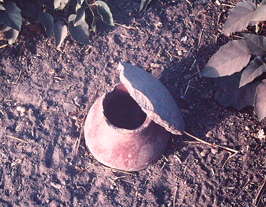
Ansoateng’s vayaam-medicine at the tampoi
If someone has died in Wiaga-Badomsa, Ansoateng receives a hint from his vayaam medicine For example, if he has had a very restless night, the following morning, he will go to his vayaam medicine, which he keeps in a clay pot by the rubbish heap (tampoi). When the medicine pot’s lid is slanted, he knows that someone has died. Ansoateng will then refill the pot with water and drink some of the medicine. He also places his hand inside to grasp some medicine and rubs his whole body with it, mainly to protect himself against the dangerous piisim smell of the corpse, which can lead to vomiting and other diseases [endnote 14].
Afterwards, he does not close the pot again. After the burial, he will peer inside it. If the root pieces (tinangsa) lie parallel, he can close the vessel again. If at least one root piece lies across another, there will be another burial soon, and he will leave the pot open.
According to Ansoateng, four types of vayaam medicine exist. All are made from tree roots:
1. Medicine from the roots of the unidentified kpagluk tree, obtained from a crocodile cave by a river. This is the most potent medicine. The gravedigger crawls into the cave and then closes it with thorns to protect himself from the crocodile that might return. Then, he cuts off pieces of the kpagluk root.
2. Medicine from crossing roots of the highly rare and unidentified yik tree.
3. Medicine from the roots of a gaab tree (Diospyros mespiliformis) that never bears fruit.
4. Medicine from the roots of the waaung-duob-pok tree (waaung duob = Prosopis africana?).
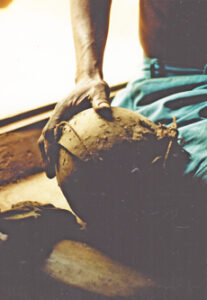
Medicine in Ansoateng’s room
Ansoateng keeps these medicines in his pot by the rubbish heap. Children and elderly women – but never childbearing women – can drink the vayaam medicine if they have been attacked by the piisim smell. These drinks are from a ‘white’ medicine that is not kept at the tampoi but in Ansoateng’s room in the compound. Women who must touch the dead can also bathe with a mixture of donkey dung and ngmanyak grass (not identified).
Immediately after death has occurred, the ‘gravediggers’ take over many key ritual acts because, among all those present, they know best what to do in such a situation. Ethnologists who think that the consent of the yeri nyono and the close relatives of the deceased is sufficient to observe and photograph the course of postmortem rites may experience great disappointment when the veto of the first gravedigger blocks their work.
Individual gravediggers have different functions and powers. Some may only dig, while others dig and bury the dead, and others again others may only bury young people (fn 03.32b). For digging a grave and the following activities in a compound, the leadership lies with an older, more experienced vayiak. He is appointed by the elder (kpagi, headman) of the dead person’s lineage, which includes the inhabitants of about 3–4 neighbouring compounds (ko-bisa). However, the official gravedigger is often not directly involved in the physical work. He may be sitting in the kusung with the elders of the compound, making crucial decisions from there and carrying out a few ritual actions on the laid-out corpse. The physically labouring gravediggers also have a leader who carries out other activities aside from the digging work (see below).
Depending on the characteristics and modes of death of the deceased, different vayaam medicines are used:
1) For lepers: without this medicine, burial is not allowed,
2) For a pregnant woman,
3) For a sakpak (a witch or sorcerer),
4) For a sakpak-yiik (the worst kind of sorcerer),
5) For a deceased whose death occurred more than two days ago (i.e. with the onset of decomposition),
6) For the dead still walking around as kokta, coarse red-brown sand is used – the dundum medicine, which is also eaten by others.
My question to Ansoateng on whether he has krupaani (or kurupaani) as a gravedigger was answered with an unequivocal ‘yes’. Without krupaani, he could not do his job; the kurupaarisa are in him. When he sees a sick person, he knows through them whether the person will die (for the definition of krupaani, see also Chapter 3.4.2, endnote 28).
When Ansoateng enters his room with various medicines and sees that part of the pregnant woman’s vayaam has fallen out of the container, he knows that the pregnant woman has died.
Burying babies is more exacting than burying a decomposing person because there must be no mistakes (see also Chapter 3.5.1: Akanchainfiik’s burial). When a child dies as a sakpak, Ansoateng breaks its hands and legs before burial so that it cannot get out of the grave.
He investigates before the burial whether the deceased was a sorcerer or witch by pinching the dead person’s arm. If the dead person pinches back, he is reasonably sure that the deceased will become a ghost (kok), so he tries to find the right medicine. Some gravediggers cut off a dead witch’s hand, ears, nose, or fingernails. If such a dead person bites the leg of a living person, without treatment the person will die after three or four days. The bitten individual seeks out a vayiak, who knocks out a tooth of the dead person in his laying-out room. He puts the tooth in the fire until it turns black. Then, he grinds it, adds some oil to it, and rubs it into the bite wound (on the leg) until it is healed.
He answered my question (again), about the direction in which the dead are buried. The heads of men face south, while their faces are directed east; the heads of women face north, and their faces point towards the west (F.K.: Akanchainfiik was also buried in this position; see Chapter 3.5.1).
If Ansoateng encounters a root while digging a grave, he cuts it on both sides and places it in his pot of vayaam medicine – if he does not do so, someone may die.
Additionally, Ansoateng showed me the dundum medicine (see above), some of which he ate in my presence. Most other medicines must be burnt or charred before one may eat them (fn 88, 100b).
After the interview, Ansoateng showed me two bright crosses (as if drawn with silver bronze) drawn on the window of his room and a round black shard on the wall by the compound entrance, providing another means of protection for the gravedigger.
3.3.2 Vayaam rituals at Angaung Yeri, Mutuensa (fn 88,236b)
On 19 March 1989, a leper from Angaung Yeri was buried by the vayaasa from his own and other compounds, including Ansoateng. Each gravedigger’s head was shaved. A medicine was prepared in a bimbili vessel and placed on the tampoi. The vayaam-bogluk was taken from the yeri nyono’s room and placed on the tampoi, where he received the sacrifice of a chicken and a sheep. All the gravediggers and others took a bath unclothed, washing off each body part with the medicine diluted in water.
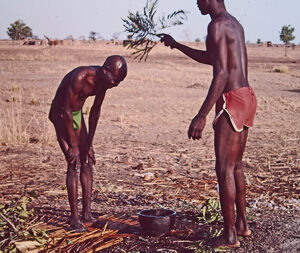
Grave diggers at the trash-heap
On the following day (20 March 1989), I learned more about burial rituals by interviewing people in Angaung Yeri and making observations. In the yeri nyono’s courtyard, the cooked meat of the sheep was distributed to everyone. Some women from their or neighbouring houses went to the tampoi, bared their upper bodies, and washed their heads, arms, and legs. Due to the daylight, they did not fully undress and did not want a photo. A shaven-headed gravedigger demonstrated bathing on the tampoi for me. There were tufts of leaves with which he washed himself off and knocked his body after dipping them into the medicine water. Such a bath also protects against numerous other diseases.
3.3.3 A vayaam ritual in Anduensa Yeri, Wiaga-Chiok
When I had touched Akanchainfiik’s corpse after her death (see below) and touching other dead people was deemed possible for me in the future, I was advised to undergo the vayaam ritual. It would protect me from the harmful effects of smelling a corpse (piisim) and be a preventive measure against ghosts.
Adaapiim, the father of my associate Adama, agreed to perform the vayaam ritual for Danlardy and me at his compound in Wiaga-Chiok.
We needed to obtain the following for this ritual: one white chicken (kpiak), one new hoe blade (kui), one jar of shea butter (kpaam), millet flour (zaa), salt (yesa) and one billy goat (bu-duk), whose testicles and penis were needed for the medicine and a medicine bag’s crafting. I was able to buy the goat for 3500 cedis at the compound. The necessary herbal parts (probably roots) would be obtained by people from Adaapiim’s family in the bush [endnote 15].
When we arrived at the compound, some of the collected medicinal species were already in a samoaning clay pot. We were told the names of ten species; three had to remain secret. After adding water, this vessel was placed on fire at 5:30 p.m. Adaapim placed the vayaam-bogluk – a closed calabash with solid, charred medicine – next to the fire. The hoe blade now lay on top of the clay pot and would receive the blood of sacrificial animals. At 6:30 p.m., a brown chicken (provided by the compound) and my white chicken were sacrificed to the two shrines. A problem arose when my white chicken would not flutter upwards after the first cut, indicating that my sacrifice was not accepted. However, after a second cut in the throat, it did flutter up. After speeches (prayers) from the compound head and me, the goat was killed in front of the shrines over a small bimbili bowl that caught the flowing blood. Then, Adaapiim let some drops of blood from the still-bleeding goat drip onto the two shrines; immediately afterwards, the goat was cut into pieces. A young gravedigger took two small pieces of charcoal from the small vayaam-bogluk. With a stone on the hoe blade and a ceramic grating bowl, he separately ground part of them into a black powder and then added salt.
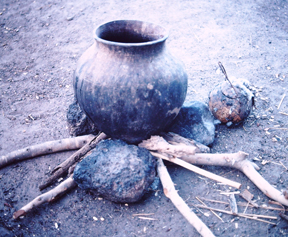
The samoaning vessel on the hearth consisting of three stones
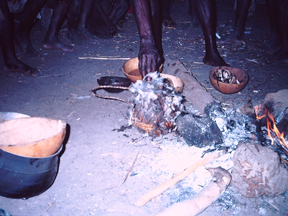
The vayaam-shrine, a calabash with traces of former sacrifices
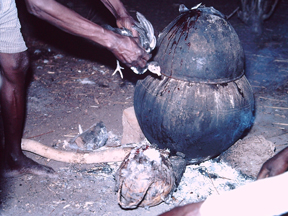
Sacrificing a fowl to the liquid medicine
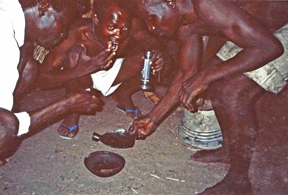
Charred medicine on the hoe-blade
Danlardy and I were then led to our bathing site behind the tampoi, where two unclothed younger gravediggers had just taken their bath. After undressing (I was allowed to keep my pants on) and assuming a squatting position, a gravedigger standing behind us poured alternating streams of steaming hot and cold medicinal water over our heads from a calabash bowl. We had been told that boiling water from the samoaning pot was used for this, but we did not need to fear: If we had not come here with evil intent, we would not suffer any burns. As the hot (boiling?) water was being poured, I ventured a look behind me. Just as the hot water was being poured, another gravedigger was pouring cold water, which mixed with the hot water in the air and on my body.
After this, a man massaged my chest, hit my legs and head with a branch of leaves quite firmly and then, more gently, hit my back.
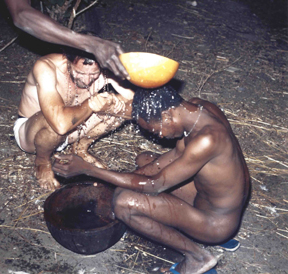
Danlardy and F. Kröger bathing with medicine-water
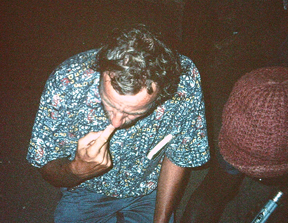
Consuming medicine
We were then led back to the hearth with the medicine pot. Meanwhile, the grated and salted charcoal medicine had been mixed with shea butter, and we had to tap our index finger three times (representing the male principle) into two different medicines and eat the medicine. Only adults who have undergone the vayaam bath before may consume this medicine.
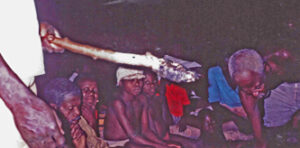 At the same time, between the tampoi and kusung, some men had prepared sa-gaang, an unfermented millet porridge. An unclothed man kneaded some millet porridge on the stirring stick and poured liquid shea butter and the black powder over the porridge. After a prayer, the medicine pot on the fire and the vayaam-bogluk received the following offerings from the compound head:
At the same time, between the tampoi and kusung, some men had prepared sa-gaang, an unfermented millet porridge. An unclothed man kneaded some millet porridge on the stirring stick and poured liquid shea butter and the black powder over the porridge. After a prayer, the medicine pot on the fire and the vayaam-bogluk received the following offerings from the compound head:
1. Clear water,
2. Millet porridge from a bowl,
3. Oily millet porridge from the stirring stick,
4. Blood soup (from the killed goat),
5. Two kinds of meat (from the two chickens?),
6. Clear water (medicine water is never sacrificed).
Danlardy and I were each given one leg and wing of a chicken and one foreleg of a goat.
At the eating area near the kusung-dok, we ate some of the millet porridge from the stirring stick. It had taken on a dark colour due to the admixture of the medicine powder. As we ate, several women and Adama’s young son bathed at the bathing place with the vayaam medicine.
Adama’s father, Adaapiim, then called Danlardy and me to the kusung. He handed us a reddish hot medicine from the samoaning. Then, he gave us a piece of the charred medicine to take home and instructed us on its use and effects: We were to grind it into a powder on a hoe blade and mix it with salt and shea butter. It should be kept in the house and only taken before dangerous or nocturnal endeavours; it should never be taken to funerals or visits. We would no longer have to fear ghosts (kokta), but we were forbidden from telling anyone if we had seen a ghost. Finally, the medicine was only for us and must not be eaten by anyone else.
Small pieces of charred vayaam medicine can also be worn on the body in an iron bracelet that has a tubular central part, where an open slit allows the medicine to exert its effect unhindered.
On 2 April 1989, Danlardy and I undertook our second bath in Chiok by having lukewarm medicine water poured over us thrice. We then had to drink the medicine three times again.
On 3 April 1989, I visited Chiok alone in the daytime. There, I was asked to wash myself by pouring the water over my body and drinking the medicine three times.
Two of Danlardy’s stepmothers wished to take this opportunity and underwent the vayaam ritual in Chiok with the same water from the samoaning pot. However, as women, they were required to come four times (representing the female principle). Each of them donated a guinea fowl (kpong) and a chicken (kpiak) as offerings to the two shrines; like us, they bathed by pouring the medicine water over them. They were not fully unclothed but wore traditional leaf clothing. ‘Men’s’ millet porridge (sa-gaang) was prepared as it had been done before, but this time there was a mixture of millet porridge and crushed medicine at the stirring stick that was not offered to the women.
After completing our ritual treatment, Adaapiim made a small bag from the skin of the goat’s testicle. He cleaned it inside using sand and filled it with liquid vayaam medicine, making it a reserve container that, like the small vayaam-bogluk, is kept in the ancestral room (dalong). Adaapiim brings it with him when he must leave the house at night. When I visited the compound on 24 April 1989, the samoaning – the large medicine pot – was still standing at the tampoi.
Upon enquiry, Adama explained that the little vayaam-bogluk could also become a segi (guardian spirit) at a segrika. The children concerned are then called Avayaam, Avayaampok, Avayaamlie, or Atiim (fn 88,252).
3.3.4 Further information on vayaam medicine
Information courtesy of the gravedigger Akperibasi, son of Ayomo Ayuali (fn 88, 188b). His vayaam medicine stands on the tampoi among shrubs. When new roots are boiled for the medicine, many neighbours come and drink from it. The medicine also helps against nausea or the consequences of eating spoiled food. When the gravedigger buries a decayed corpse, he drinks from this medicine and washes his hands and feet with it.
Information from the gravedigger Ayomo Ayuali (20.11.88, fn 88,110a). At the kusung stands Ayomo’s dachoruk (spade), which is used for digging graves as well as postholes. (fn 88, 173b) As gravediggers, Ayomo and his eldest son, Akperibasi, are not allowed to make a dachoruk themselves.
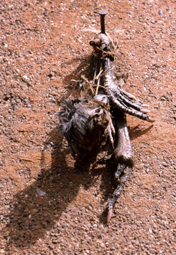
Fowl’s feet outside of Ayomo’s ancestral room
On the outside wall of Ayomo’s kpilima dok hang some chicken feet, which come from a nang fobka ritual (see below) in Sichaasa. It involves an animal’s tail being moved around the death mat three times for a male dead person and four times for a female. Then, a chicken is struck dead on the ground. The chicken was given to Ayomo because he was the leader of the gravediggers. He will use its feet for his vayaam medicine; one day, a billy goat (bu-dok-tiik) and a red chicken (kpa-moaning) will be sacrificed to it on the tampoi. A black hoe blade not yet used for rubbing medicine is added. All those who wish to participate in the ritual have their head’s hair shaved with a loose razor blade. After shaving, water is boiled with medicine (tinang), and all participants have the hot water poured over their shaved heads, armpits, buttocks, and backs of their knees. Then, a chicken foot (see above) will be charred and ground, and oil and glowing charcoal will be added to the mix, producing smoke. All participants will inhale the smoke and hold their elbows, knees and feet over it. They then eat the charred and ground medicine.
If the dead man’s medicine is more potent than his own, Ayomo will die (fn 88,238a).
Information from Adama, Chiok (fn 88,241a): There are two kinds of baths: 1. to allow burying different (e.g. already decomposed) corpses. 2. to prevent encounters with ghosts.
Information from Akanming (fn 88,136a): If an unauthorised person touches the vayaam shrine, he must sacrifice a chicken.
Information from the tiim-nyono of Yisobsa (fn 94,23a): He makes vayaam medicine from the roots of beli-cham and vayaam-tengnang (tinang?) trees by digging up the roots and soaking them in cold water. For example, those who suffer from the effects of piisim and have swollen limbs bathe in this extract. Some roots can also be eaten in their charred state.
3.4 Burial of adults
3.4.1 Death of a married woman (case study from Wiaga-Yisobsa)
Only once was I able to observe and document the entirety of the rites performed for and on a deceased person in all details: In the compound of my assistant, Yaw (Apok Yeri, Wiaga-Yisobsa, fn 02/3,31a-35b). This was likely because my assistant Yaw was the ‘chief mourner’ (kumu nyono; literally, the ‘owner of the funeral’) on behalf of his father, who lived in southern Ghana, and because Agyenta, the father of my long-time friend Alfred (now the Catholic bishop of the diocese of Bolgatanga/Navrongo), was the leader of the vayaasa.
3.4.1.1 Treatment of the dead woman and rituals before burial
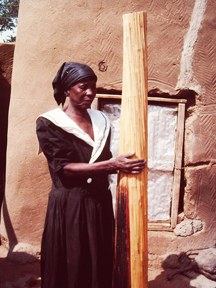
Ama with the death mat
Yaw’s sister, Asiuklie, had died in Sandema Hospital on the night of 3–4 January 2003. Yaw and I had taken her body in the back of a pickup truck to Apok Yeri in Wiaga. If Asiuklie had been buried in Sandema, her death would have been considered a death in a foreign land (sagi; literally ‘bush’), as she had not visited Apok Yeri before returning from southern Ghana. Some soil would have been taken from her grave and buried in a ngarika burial (see below) in Apok Yeri (fn 02/3,35b).
After we arrived in Apok Yeri, they initially wanted to lay the body in the dalong on a cloth, but a man from Apok Yeri was successful in his objection to this, so she was laid on a straw mat (tiak) provided by the Ama of the compound [endnote 16]. When the chosen gravediggers (vayaasa) first entered the room of the dead, they cleared their throats to announce their arrival. They tapped the floor with the flat of their hand four times (thrice for a male dead). Subsequently, they were allowed to touch the corpse.
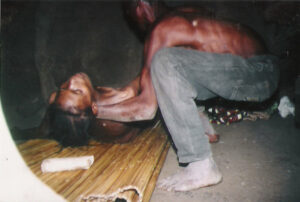
Laying the dead woman onto the mat
Some older women undressed the dead and put a plain, dark-coloured waist cord on her, into which a leaf apron could also have been hung [endnote 17] if they had not later put a woven strip (garuk-pali) around her hips as a cloth garment. Her old clothes were washed and would later, with other things from her possession, be displayed at the granary (bui) at her funeral celebration. Afterwards, they could be worn by, for example, her younger sister. However, many women are afraid to don the clothes of a dead person.
Next, the women wiped the dead woman’s body with a wet cloth. Shaving Asiuklie’s head hair caused problems in the proceedings, as all those asked to do so refused out of fear. Finally, Yaw – against all traditions – performed this work himself (fn 02/3,33a).
Older women were typically supposed to carry out the massage of the corpse to keep the body supple for burial through a narrow shaft. However, they feared this task, so gravediggers Agyenta and Agbong [endnote 18] carried out this activity (fn 02/3,33a).
3.4.1.2 Suurika (fn 02/3,31b) and other rites
Some other rites had to be performed before the burial. At about 1:40 p.m., Yaw drank a bowl of reddish millet water (zamonta-zom) next to his dead sister; a woman said a few words about it, mentioning that this was a welcome drink for Asiuklie, who had returned from southern Ghana as a ‘stranger’ and had not visited her compound before her death. Yaw drank the millet water in his sister’s place. This ritual is called suurika (here: ‘rinsing the mouth’), tugka (‘receiving [a drink]’) or tutok moangka (‘wetting the throat’).
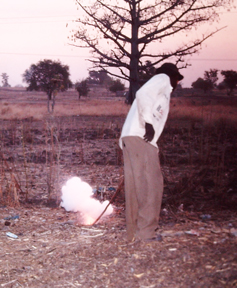
Igniting a firecracker
Before the burial and, the question was asked in the kusung, whether all problems concerning the dead had been solved. Yaw’s mother reported that Yaw had quarrelled with his sister in Sandema. After initial reluctance, Yaw underwent a purification ritual in which he and a compound dweller held a very small, light brown chicken, which was then cut in two in this position (kpiak gebika, fn 02/3,32a+33a; see also Ngarika Burial, Chapter 3.7.2.1, with photo). I was allowed to participate in this ritual. Knowing that photos were probably undesirable, however, I refrained from taking them.
Yaw wanted firecracker shots (dagoong naka) to be fired before the burial, while the oldest neighbour (Asiidem) ruled this out completely, as no shots had been fired at the previous burials of older men. A compromise was found by agreeing to fire two shots: the first for the recently deceased and the second for Asiuklie. Only the names of two deceased men and an elderly woman were mentioned before the first shot was fired, but others were included.
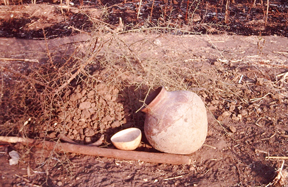
The liik vessel, the calabash bowl and the dachoruk
Immediately before the burial, two women mimed filling a large liik vessel with water at a place between the grave and the compound entrance. Although they made the motion of filling it with a calabash bowl, the bowl was empty. The ‘water’ was meant to quench Asiuklie’s thirst. In other compounds, the vessel may be genuinely filled with water. According to other information from Ansoateng (Badomsa), the water is also used to mix clay mortar for plastering the burial bowl.
The liik vessel with the calabash would remain at the grave until the hanging of the mat (ta-pili yika) – or even for a long time afterwards – and would then be brought to the dalong. According to my informants, water is fetched in this liik for food preparation during the funeral. At the funeral’s end, the woman who organised the widow’s bath receives the vessel as a gift.
3.4.1.3 Announcement of death (kuub darika) and condolence visits
The kuub darika consisted mainly of the notification of Asiidem, the elder (kpagi) of the ko-bisa of Apok Yeri, who lived in a neighbouring house. Asiidem, for his part, notified most of the other relatives.
After the beginning of the kuub darika and the start of the grave digging, mourning expressions by people of the compound and relatives or friends who lived far away began. The sequence of mourning rites in Apok Yeri proceeded as described in general terms above (Chapter 2.7).
3.4.1.4 The excavation of the grave and the burial
Since the dead Asiuklie was considered a childless daughter of the house (yeri-lie) in Apok Yeri, she had to be buried outside the compound (fn 02/3,31a). At the intended location of her grave, one would usually place a large, upturned calabash bowl and throw any stone against it. Relatedly, I observed that at a man’s funeral, three stones were thrown against the calabash (for a woman, it would have been four stones). The first and failed attempt to dig a shaft for Asiuklie’s grave was attributed to the omission of this brief ritual.
The shaft work at Apok Yeri was completed using the following tools:
1. Two axe blades for the dachoruk grave spade,
2. A straight, peeled branch of a nim-tree, which served as the handle of the dachoruk spade,
3. Two calabash bowls for shovelling out the earth previously loosened with the spade,
4. And a hoe.
The gravediggers began their work by removing the millet stubble from the last harvest and levelling the ground at the site of the planned grave. A cone-shaped hut (vorib noai kusung) was built around the grave site from millet stalks placed next to each other. It served less to provide shade for the workers than as a screen to protect them from the prying eyes of bystanders. Only the five gravediggers and relatives of the dead were allowed to enter this ‘hut’. According to another taboo (kisuk), mentioning the name of a living person near the gravesite would lead to the death of the taboo-breakers.
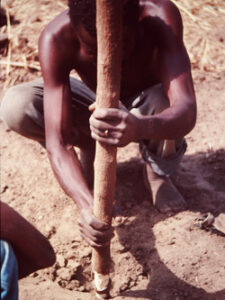
Beginining the grave-digging with a dachoruk
At 1:30 p.m., with the help of the dachoruk, the first small hole was made in the ground and then enlarged according to the circumference of the ceramic burial bowl, which was later placed on top. Initially, loose dirt was removed by hand and later with a calabash. After reaching a depth of about 20 cm, the workers came up against hard rock, and the work progressed slowly despite a gravedigger fetching a stronger iron blade from his compound.
Then, a worker placed the dachoruk spade over the open burial hole. The householder gave the gravediggers a brown chicken (vorub kpiak), which they killed without bloodshed by striking the dachoruk handle. According to information from Badomsa, the chicken should first be moved in a circle over the grave hole three times in the case of a male dead person and four times in the case of a female dead person (yulimka). If the fowl is not immediately dead, it is killed by kicking it. Under no circumstances should it flap its wings before dying. Later, the men grilled the chicken over an open fire and ate it together. A bowl of millet water – also an obligatory gift – was drunk immediately. In addition (but not due to obligation), they received a bowl of peanuts, akpeteshi, from which a libation was poured on the ground, millet beer, and tobacco. Sometimes, gravediggers are also given a goat or a sheep – the latter for a compound head’s grave – instead of a chicken.
After this interruption of the excavation, the unfinished grave hole was filled with earth, and digging began at another site. When the burial shaft had reached a depth of about one metre, it was widened from its lower bottom in all directions so that a narrow, circular base with a diameter of about one metre was created, approximately twice as large as the entrance opening [endnote 19]. A gravedigger descended to try out whether it was big enough and demonstrate to me the body position of the dead. The dead person assumes a crouched foetal position with both hands in front of his ears, which, according to information from elsewhere, is to prevent sand from entering. For old men, this is achieved by placing a hoe blade on each ear [endnote 20]. A buried woman’s head points to the north and her face to the west; the head of a man to the south and his face to the east (information from Sandema-Kalijiisa, Wiaga-Badomsa). Women lie on their left side, men on their right (information from Danlardy Leander, fn 94,86).
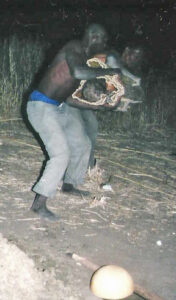
The corpse is carried to the grave
Asiuklie’s body was carried to the grave in her mat by two gravediggers and buried there in the dug-out burial chamber. The gravediggers then filled the grave completely with earth (sika: filling up) and tamped it down with the wooden end of their dachoruk so that it could not collapse later. A ceramic chari bowl, which is called boosuk in this function, served as the upper grave closure,; it could be old or new, brown or black, but it must not have a crack. Near the grave, Agbong poked (vuri) a small hole in the upper part of the bowl so that the dead person’s soul (chiik) could exit and reenter unhindered until the first funeral celebration. The soul mostly stays with its death mat in the dalong, but it can also visit the grave and the corpse for a short time.
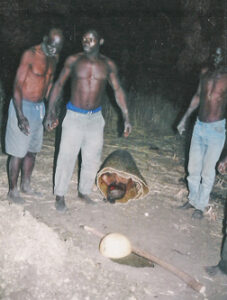
Before the entombment
Before Agbong placed the bowl on the filled shaft, he made a few circular movements with the bowl (yulimka). When placing the bowl, he had to ensure that the small hole in the bowl was pointing in the correct direction. While much information and observations on graves prove that the hole in the bowl of a woman points to the west and that of a man to the east, the opposite was claimed in Apok Yeri (source: Yaw).
After the burial, the funerary mat was rolled up again and returned to the dalong.
On a visit to Apok Yeri on 9 January 2003 (five days after the burial), the hoe handle, the wooden dachoruk handle, and the liik pot remained lying at the grave. Instead of a plaster, a layer of earth had been placed over the grave bowl. Branches of thorns were likely to prevent the bowl’s destruction by domestic animals.
If one wants to use these wooden handles later, they must undergo the nyiinika cleaning ritual. However, they usually remain at the grave until they rot, or else children take them away and use them as toys.
As described previously, women had only mimed filling the liik vessel and the calabash with virtual water to serve as a potion for the dead. From another empty vessel, they now feigned the act of pouring water without actual water flowing [endnote 21].
The two shovel calabashes were lying at the compound’s main entrance for a short time. Then, they were placed on the roof of the kusung. According to Yaw, these are ritually broken during the Juka funeral together with other calabashes and clay pots (see below) if they are still present. The iron blades of the dachoruk and the calabashes lay at the compound entrance, and they were only taken into the dalong after the hanging of the mat (ta-pili yika). Asiuklie’s funerary mat stood in front of the dalong, and next to it was a wooden box of the deceased containing her personal belongings (clothes, jewellery, etc.).
3.4.1.5 Ta-pili Yika (hanging of the death mat, cf. Chapter Ngarika, 3.7.1.5)
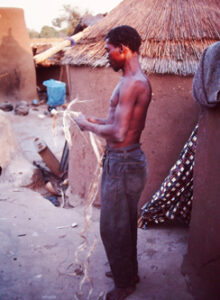
Preparing the hanging of the mat; right: the death mat wrapped in a cloth
All death mats of deceased persons are kept on a slatted frame under the dalong’s ceiling until the first funeral celebration (Kumsa). Sometimes, up to a dozen death mats can accumulate there at once. The yeri nyono’s first wife (Ama) must know exactly which mat belongs to which dead person.
After the dead person’s burial, the mat is wrapped in the middle with a cloth and placed vertically in front of the dalong in the first wife’s courtyard. If, after three days, the date for a timely funeral celebration has not been set, the mat is stored under the dalong’s ceiling. Otherwise, it remains upright in the courtyard [endnote 22], meaning that the funeral rites continue without interruption – or, as Aduedem (2019:13) puts it, ‘Ba deri siak yiili’ (literally, ‘they should just sing the song’, i.e. they should just continue with the funeral rite).
The ritual of hanging the mats (ta-pili yika, [endnote 23]) is usually performed soon after the burial; according to information from Badomsa, it is performed three days after the burial of a man and four days after the burial of a woman. The gravediggers are given millet water, millet beer, and akpeteshi for this, but no chickens.
In Apok Yeri, the ta-pili yika ritual occurred on 10 January 2003, 6 days after the funeral. Agbong, a gravedigger (vayiak), and a man from the neighbouring compound, Achumbe Yeri, performed it. Both were bare-chested and wore no footwear. They took Asiuklie’s mat wrapped in a cloth from the dalong, removed the cloth, spread the mat out in the courtyard, and added a very simple wooden neck support (zu-kpagluk or da-fieluk) before rolling it up again. This neck support consisted of a branch piece about 30 cm long, slightly tapered in the middle with an axe. Agbong had already made this object on 4 January; it had lain under Asiuklie’s head during her laying out.
The two men wrapped the rolled mat with the white fibre (bog-pieluk) in three places. With a twisted cord (miik), they hung it under the dalong’s ceiling. As termites can destroy the fibre cord, the men both regretted not having a wire or nylon cord for this; the mat falling down would have been a bad sign.
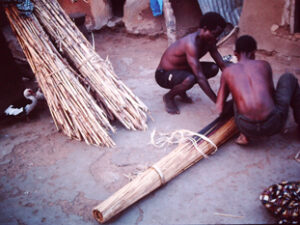
Lacing the mat
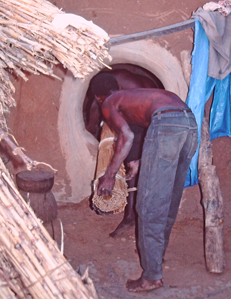
The mat at the entrance of the dalong
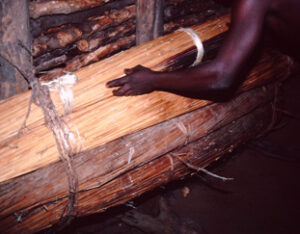
The mat witih other death mats under the ceiling of the dalong
3.4.1.6 Discussions in Apok Yeri about the noai-boka and gaasika rituals
(fn 02/03 34a + 35b) On 10 January 2003, at about 5:15 p.m., several older and younger men had gathered in the kusung and discussed the subsequent ritual activities. This conversation included whether the noai-boka, a rite with the death mat to determine the person guilty of death, should be performed. The most important arguments against performing this rite were that it had not been performed earlier for two previously deceased women with similar social and genealogical positions, whose mats were also hanging in the dalong. Moreover, the mother of one of these women lived in southern Ghana, and was very difficult to reach for a re-enactment of the rite (for the performance of the noai-boka ritual, see also Chapters 3.7.1 and 3.8, endnote?).
The performance of the gaasika ritual to prevent further children of Yaw’s mother, Akawai, from dying also led to a contentious general discussion. As Christians, Yaw and his mother were strictly against it and were able to assert themselves.
Otherwise, this ritual would have taken place in Ayinyam Yeri, the compound of Akawai’s sanyigmo (matchmaker). The women of this compound would have prepared millet porridge (saab) with jum-soblik (mudfish, Clarias sp.) and sauce. In the main courtyard of the first wife, Akawai would have held some of this porridge in her right hand [endnote 24], only to throw it away, saying, ‘Mi piilim bia-kaasung ale nna. Kaasung toaling jam-ya. Fi me ngoa cheng ngang vuutinga. Kan ngman nya kaasima’. (‘This was my first miscarriage. Destruction [death] has already come. You should leave the living [alone]. They should not see the corruption [death] again’). This would have happened three times; during the fourth, Akawai would have eaten the food. Then, her hair would be shorn, and they would take her back to Apok Yeri. The next day, Akawai would have made a final visit to Anyiyam Yeri [endnote 25].
By omitting the gaasika, proponents believed that Akawai, who was about 60 years old, could have further ‘miscarriages’, meaning that more of her childless sons and daughters could die unless the gaasika was made up later. If Akawai’s young daughter Rosemon miscarried, it might be possible to perform the gaasika ritual on her in a foreign compound, but not in Apok Yeri.
Akawai’s refusal would also mean that this ritual would be henceforth forbidden to children of hers who have living children without preceding miscarriages, as is the case in Yaw’s family, for example.
3.4.1.7 Further information on the gaasika
Information from Danlardy Leander (fn 02/3, 53a): The gaasika (with haircut) of Danlardy’s ‘sister-in-law’ (FBSW) with several children was performed in her parental home ‘because she was the only daughter’. Her husband’s compound gave the performers a guinea fowl (kpong).
Information from Margaret Arnheim (fn M1978ff. 52a): If the woman whose head is to be shaved is working in public service, for example, and she does not wish to have her hair shorn fully, the poning knife may be used to shave a tiny patch of her hair.
3.4.1.8 Nyiinika (purification by smoke)
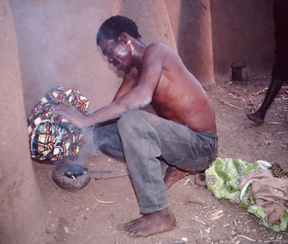
The cloth of the mat is cleaned by smoking
The nyiinika ritual is intended to prevent bad influences from the tools used in the previous death rituals. It always takes place not far from the compound entrance after the mat’s hanging.
In Apok Yeri (fn 02/03, 35a), pure chicken dung (to which ngmanjek grass is added in some other compounds) is burned to produce a smoke believed to have a purifying effect and to remove the odour of death from used objects. Agbong, the first of the active gravediggers, held the following objects above the smoke:
1. The liak blade of the dachoruk spade,
2. The hoe blade (kunkuri),
3. Dagunta, the iron pipes from which firecrackers were fired,
4. The knife (gebik) with which the chicken’s throat was cut in the kpiak gebika ritual,
5. The calabash with which the liik pot was virtually filled,
6. The liik pot,
7. Asiuklie’s clothes and the large cloth that covered her body on the mat, which was later wrapped around the rolled-up mat.
8. Some people also held their hands over the smoke.
After the nyiinika, the gravediggers washed their hands with water. Two shots fired indicated the completion of all ritual activities.
Before their farewell, the gravediggers present were served with two bottles of akpeteshi and millet water.
3.4.1.9 Excursus: Daungta suurika (literally “washing away of dirt”): purification by smoke and water.
(Own observation and information by Danlardy, fn 88,91a).
The daungta suurika or daungta nyiinika ritual, which I observed in Anyenangdu Yeri on 6 November 1988, probably had a similar function to the nyiinika ritual after burials.
My assistant Danlardy Leander was engaged to a daughter of the Kadema Chief when she passed away at the Wiaga Clinic on 5 November 1988.
After a libation on the ground (piika) in front of the tractor, Anamogsi’s son drove her body to her parents’ house in Kadema at 1a.m. The girl was lying on the trailer of the tractor on a camping bed of the clinic. Next to her, relatives wailed and mourned throughout the drive. Anamogsi had to cancel all commercial trips planned with the tractor afterwards. The Kadema-chief immediately sent him a sheep.
On 6 November 1988, in the afternoon at 5 p.m., one of Anamogsi’s sons drove the tractor to the dam to wash it thoroughly. At around 6.15 p.m., the cleansing ritual daungta suurika had to be performed on the forecourt (pielim) of Anyenangdu Yeri, because some spiritual dirt (daung) still stuck to the tractor despite the washing. Someone fetched a shard with heavily smoking ash [endnote 26] from the house and placed it next to the tractor while Anamogsi delivered a short speech (prayer?). Afterwards, the shard with the smoking ashes was placed on the trailer.
Offerings to Anamogsi’s father Aluechari followed: first millet water, then the blood of a dark chicken. The donated sheep was first led to the shrine (bogluk) and its head held on it before being killed next to the shrine. Its blood flowed into a cheng pot. The young sacrificer (Atoa) took a stalk of millet, dipped it in the blood and placed it on the shrine (F.K.: It was probably meant to represent the sheep’s collar). The sheep was immediately skinned and its flesh was divided. The entrails to be sacrificed were roasted by children on an open fire: chicken liver, chicken meat, sheep liver, and sheep meat. Then the sheep was divided: one hind leg went to Anamogsi and Atinang (ko-bisa), one hind leg to Atuiri and Angoong Yeri (ko-bisa), one front leg to the tractor driver from Wiaga-Goansa, I received one front leg and most of the liver remaining after the sacrifice (I was considered the eldest son of Anamogsi). The breast (kusiri) was distributed to all Anyenangdu Yeri households and the hip (chiak) and the offal were given to the children of the household, the head to Atoa as the sacrificer, and the skin to Anamogsi’s son Akaayaabisa, who had skinned the sheep and was also in need of a skin for a new leather apron (tangkalung).
Daungta suurika in Aniok Yeri
(Anamogsi, fn 88,239a) Agaam (name changed), the leader of the Badomsa instrumental group had a fatal tractor accident after a trip home from Sandema [endnote 27]. Immediately after Agaam’s burial, at about 8 o’clock, a fresh chicken egg was broken and akpeteshi poured over the engine of the tractor at Aniok Yeri to clean it. In the evening, a similar suurika took place as in Anyenangdu Yeri, after the death of the Kadema girl. However, only one chicken was sacrificed (rites not observed by F.K.).
The exterior guilt of the accident was clear to everybody. The victim, who was completely drunk, was sitting between the tractor and its trailer and after falling down he was rolled over by the wheels of the trailer. Apart from his ancestors and the Pung Muning tanggbain, to whom he refused to sacrifice, some blame was also assigned to the tractor and provided a reason for the purification rites on the tractor. Anamogsi once told me (fn 88,98a):
Ba nyeem ni (=le) ween soka la, ba nye nganta bala, a nye te logni, di kan ngman kaasi wara. Ba dan kan so di, ku a fe ma [= kama] te di ngman ko nuru de me ya nye dila. Nganta bala; ba boa ween bala ween bala a nyese ti-baasa la, krupaani, se tiiba asa la…. se krupaani.
They used to talk about washing [cleaning the tractor], they used these things not to let the lorry spoil anything again. If they do not clean it, it will necessarily kill somebody again. That is how it is; these things, they say, these things resemble evil trees; [bad trees have] krupaani, like evil trees, like krupaani [endnote 28].
3.4.2 Apunglie’s Death (fn 94,21a)
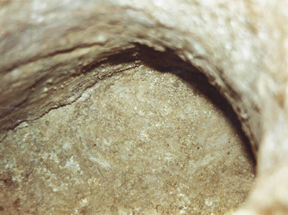
The burial shaft was widened at the bottom.
Apunglie, an old woman, Atinang’s sister [endnote 29], died at Atinang Yeri, Badomsa on the night of 16 July 1994. At 10.20 a.m. her death was indicated by three firecracker shots. At 10.40 a.m., Amaami and Azakopo (sons of Anamogsi) came to take me to Atinang Yeri. There, the younger people were sitting in the kusung, the old men (Ayomo, Anamogsi, Angmarisi, and Atinang) in the kusung-dok.
At 11 a.m., the grave diggers (Ansoateng, Ayomo Ayuali, Ayogsi from Anue Yeri, Atongka, Asiame Amoabil, Abanyub, Ayoma Anyiik and Aparimoak) finished digging the grave in the cattle yard. Over the grave they had erected a roof covered with a plastic sheet and wu-panung grass. The grave was about 1 metre deep, and the protrusions at the bottom were not the full length of the body. Tools used were a dachoruk with a very wide blade, a hoe, a calabash and a liik jar.
New mourners, crying loudly, kept arriving. From the kusung I watched Apunglie being carried out of her courtyard in a mat. Her head was shaved bald (?). Not only gravediggers carried the mat with the body, but some young men from the kusung had also been asked to help.
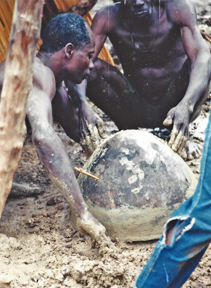
Ansoateng puts a stick into the air hole.
After the burial, firecrackers were fired again. From a very close distance, I was able to observe the filling of the grave, the construction of a mound of mud over it and the placing of the boosuk bowl on the mound of mud. The bowl had been brought to the kusung by a woman of the house, and a man carried it to the grave. The shaft (vorub) was first filled with the excavated yellow earth, then also with broken pieces of wall. Ansoateng trampled down the loose earth with one foot, and the pieces of wall with a beam from the grave’s shade roof, which was thus partly demolished. Then he put a small stick into the small air hole of the boosuk bowl, and on it he applied a layer of earth about 20 cm thick, spread by his hand.
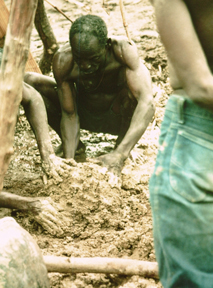
The mound’s mud plaster is spread with the hands.
Aparimoak (the most senior gravedigger?) and another gravedigger (neither of whom I know personally) disagreed with my photographs. Ayomo Ayuali, who only lent a hand now and then, his son Akperibasi, a Mutuensa man and Ansoateng defended me (Atongka remained silent). All the gravediggers washed their hands (and their faces?) together over the grave. Then Aparimoak reported to the men in the kusung-dok that the work was done. On 20 July 1994, that is on the 4th day after death (as is customary when burying a woman), the noai-boka ritual took place in the morning, and the hanging of the mat (ta-pili yika) in the afternoon. Everything was concluded with firecracker shots (This was done when I joined). In the kusung Atinang, Angmarisi, Ansoateng, Anamogsi, John Akanming, Asuebisa, Atoa, Anyik, Akabre and two other young men were sitting. The mood was more relaxed this time, only Apunglie’s brother Atinang was very silent.
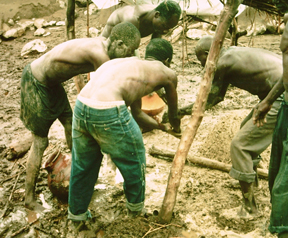
The gravediggers washing their hands over the grave
If I was not allowed to take part in all the ritual acts on a woman from the neighbouring compound whom I had known personally, this was not due to Atinang, the head of the compound, but solely to the head gravedigger Aparimoak, whom I did not know personally and whom I had perhaps not sufficiently considered with my gifts. Almost all the other gravediggers approved of my participation and later willingly gave me information.
3.4.3 Additions by other informants and authors on adult burials
3.4.3.1 Additions by J. Aduedem (Sandema-Bilinsa-Pungsa)
In 2019, the seminarian Joseph Aduedem discussed the question of whether Catholic Christians may conduct and participate in traditional burials and funeral celebrations. To this end, he also produced a not-yet-published, extensive description of Bulsa burials and “funerals”. The most important (and only?) informant was his grandfather (FF) Aduedem Alanjo, who, in my opinion, possessed a profound and exact knowledge of the aforementioned subjects. Joseph Aduedem’s research findings form an important complement to my own research in many respects, firstly because everything is seen from Sandema’s perspective, whereas the focus of my work was mainly on Wiaga. In addition, based on his grandfather’s insider knowledge, he also describes phenomena that are not readily apparent to visitors to a burial or funeral rituals. In addition, the focus in Aduedem’s texts is on rites and events (e.g., at the Juka funeral celebrations), which could only be documented to a lesser extent by me. Therefore, some important descriptions and results of Aduedem on the burials of adults, especially as far as they have not been dealt with by me in a similar form, will be excerpted in the following.
Excerpts from his unpublished manuscript (2019: 7ff.) on burials at Sandema-Bilinsa-Pungsa:
p.7f: The general mourning: When the noai-boka is over, the mat is carried back to the dalong and the general mourning starts [endnote 30]. Mourning involves wailing [and starts in front of the compound]. While the wailing women move into the courtyard (dabiak), the men stop at the kraal [cattle yard] and move back. Each mourner is usually held by agemates called vaang-chaab. These colleagues would be around the bereaved person until the funeral [burial] was over. After this formal mourning ritual, the mourners wash their faces with clear water [endnote 31].
p.8: …The gravediggers come to the kusung dok to tell the elders that they want to get a place for the deceased’s grave.
p. 8f: At a point they [the gravediggers] will stop [the digging] and go to inform the elders that “the grave does not go down” and zo-nyiam (millet water), daam (akpeteshi), groundnuts (if there are any) and tobacco are sent to the grave side as gifts for the gravediggers [endnote 32]. One of the gravediggers burns the tobacco and its smoke is blown into the grave to drive away any living soul that might have entered [endnote 33]. Later, a fowl and a goat or sheep are also sent for sacrifice [endnote 34].
The digging then continues, the opening is round, about eighteen inches in diameter, but at the depth of about a foot it increases in size and becomes semi-circular, running north and south and reaching a depth of about four feet [endnote 35].
p. 10:After the ritual in the dalong the burial proper begins. The mat containing the corpse dressed in burial clothes (i.e. golung, kurukoluk, garigeli and zutok), is carried by two gravediggers on their left shoulders to the tomb, the one with the head side being in front [endnote 36] …One of the gravediggers climbs down and receives the corpse, feet first this time, and places it on its side, facing east or west according to whether it is a man or woman respectively [endnote 37]… If the deceased is a man, his last born is called for the bogta nari ritual [endnote 38]. In this ritual, women take shea butter in a chinbili (a small calabash, ordinarily used either for sowing or serving shea butter), and another closes the eyes of the lastborn and he is led to the grave. Over there, the gravediggers take his hand and that of the corpse and rub them together lubricated by the bogta (Hyptissuaveolens Labiatae [endnote 39]) [and shea butter?], indicating that that is his (the deceased) last achievement in terms of procreation. After that, the first born comes to bury the father by placing the father well, and when this is done, he throws soil into the tomb three times [endnote 40].
p.11: After that [finishing the digging] the gravediggers come to the entrance of the kusung and inform the elders that “he (the deceased) said he can no longer live with us and so we have looked for a place for him [endnote 41].” They are thanked and the sons get refreshment (zo-nyiam, groundnuts, and akpeteshi, daam in Buli) for the elders, women and the gravediggers.
3.4.3.2 Additions by Leander Amoak (Wiaga-Badomsa)
Detailed information was provided by my long-time colleague Leander Amoak and, after his death (1983), by his son Danlardy Leander.
(fn 81,31b) As reported above, the dead person is carried to the grave in a mat. Someone goes ahead with the boosuk bowl with moist earth in it. With this mortar the boosuk is fixed to the earth.
(fn 81,10b) Through the small hole, which is placed about 3/4 of the way up in the burial bowl, the soul of the dead person (chiik), can later exit and enter. It also serves for breathing and ventilation [F.K.: This can only be meant symbolically, because above the corpse there is a layer of earth about 1 m thick that has been tamped down]. After the last funeral celebration, when the soul has moved into the realm of the dead (e.g., Ajiira), the hole in the bowl is sealed by the mud or cement coating of the bowl. The plastering could be done by any of the deceased’s wives or daughters. In Leander’s traditional compound, however, this is always done by the widow of his elder brother Atiim.
(fn 81,31a) If a grave lid is destroyed or has a crack, an “animal” (dung) must be slaughtered in a non-sacrificial act. The meat is distributed among the guests present.
Leander Amoak has attended numerous funerals as the elder of a lineage segment (Ayarik-bisa) whose differences in their proceedings seem to depend also on the importance of the deceased person. When Asage, the eldest man of Badomsa and head of a Badomsa lineage segment (Ayok-bisa) died, a burial took place that exceeded ordinary burials in its expense by far (fn 81,52a): It was a great feast with drummers, dances, war dances, rifle firing, etc. Grave diggers were: Ayomo Ayuali, Asaaluk, Adok, Akpiedem, Alaata, Ajiak and Amoak (Asage’s eldest son). Asage was buried in his mother’s courtyard. He wore the following clothes: a triangular loincloth (golung), a white robe (tagurik) and a cap (zutok). Two hoe blades were placed on his ears. As sacrifices were made [F.K.: to whom?]: one chicken, one sheep and millet water. Although Asage fully professed traditional religion, a knife was read for him at the Wiaga Catholic Church.
Leander pointed out that there are also major regional differences between sections in the process of burials. The graves in Wiaga-Guuta, for example, are usually covered with stones so that the ceramic bowls are no longer visible (fn 78,1b).
(fn 81,12a): Akadiri, the founder of the Yimonsa chiefdom, ordered his people to put him in the grave alive. However, they left a hole for him to breathe. People talked and still talk to him through this hole. His funeral celebration has not been held to this day. No stranger (not even a Bulsa from another section) is allowed to enter his compound.
3.4.3.3 Information by Danlardy Leander (after the death of his father, Leander Amoak, 1983)
(fn 84,14a and fn 94,20b) After Leander’s death, many people came to Leander’s traditional compound Asik Yeri. Everyone of his compound attended the burial (including small children).
During his lifetime Leander had told me that his gravediggers would probably be Ayomo Ayuali and Adiak. He would have been right if Adiak, who died before Leander, had not been replaced by Leander’s neighbour Asaaluk with some more helpers. These were official grave diggers who also were later the mat bearers at the noai-boka. They started digging the grave after dusk so that at sunrise, Leander could be buried. In the grave he wore a blue and white smock (garuk) with a cap, but without sandals. All the bracelets and amulets were taken from him.
In his written work for his teacher’s examination, Danlardy summarises the course of the burial activities [endnote 42]:
[fn 86,12a]: The head of the dead is shorn, their bodies bathed. Elderly men wear a loincloth (golung). If the eldest son wishes, his father is buried with golung, or otherwise he is completely naked [as it seems to have been common in the past]. A dead woman’s head is also shaved, she wears no cloth dress, only a waist cord (pak) and a leaf or fibre apron (vaata). In the kusung, the old men deliberate on who should announce the death. Before burying a woman, firecracker shots [from dagoong pipes] are set off. A messenger is sent to her parents’ house to ask if they want to see their daughter again before burial.
In a telephone conversation and additions through e-mails Danlardy told me:
The Sandemnaab died on 14 November 2006. Immediately after his death, his sons took the body in their own cars to Bolgatanga, where it was kept in the freezer compartment of a mortuary. On the evening of 26 January 2007, the same sons took the body to Sandema where it was buried secretly at around 2 a.m. (27 January 2007). At daybreak, a lot of people came and firecrackers were also fired. At the same time as the chief, a daughter-in-law of the chief died in Accra. Because of the events in Sandema, she was not allowed to be buried until 17 February 2007.
3.4.3.4 Additions by Godfrey Achaw (Sandema-Kalijiisa)
(fn 73,46): On burial day, a round hole is dug by usually more than two gravediggers. It is about six feet deep, but only three feet if the ground is hard. At the bottom of the grave, body-size bulges are dug to the north and south.
Only one person is buried per grave. Godfrey is not sure if two brothers can be buried in one grave. The eldest son of the deceased makes sure that everything is done properly.
The dead person is carried to the grave in two mats rolled up on top of each other by two male grave diggers. If he has to be transported over a wall, others can help. One of the two mats is placed vertically around the grave. Only relatives are allowed to enter the space inside the mat. The dead person, still lying on the other mat, is lowered feet first and placed at the bottom of the grave by a gravedigger. The grave is filled with earth and a mud bowl is placed on the grave hole. Moist earth is placed over the bowl in such a way that the hemispherical shape is preserved. Then the mat is removed [F.K.: this probably means it is brought back into the house].
Sacrifices over a grave, which should always be kept free of weeds, are only made at funeral celebrations.
3.4.3.5 Additions by Anamogsi (Badomsa)
(fn 97,13a): When a married woman who has not borne a child dies, one makes a hole in the outer wall (from the top to the bottom). Through this “gap”, the woman’s body is carried out of the compound to the gravesite. After the death of a deceased pregnant woman, the same ritual is performed. In contrast to the childless wife, the pregnant woman died an evil death (kum-biok).
3.4.3.6 Additions by Margaret Arnheim (Gbedema)
(fn M52a): If, shortly after the death of a person, a soothsayer determines that the dead person was a witch or wizard, they will have their legs and arms broken in the joints shortly before they are laid in the grave. Which of the gravediggers does it must remain secret, and even close relatives (wives, children) are not let in on this secret. The grave bowl of such people is not given the small hole shortly before it is placed on the grave. In order to keep the witchcraft of the dead person secret, another bowl with a hole is placed over the one without a hole. The relatives recognise the breakage of the bones by the fact that the spirit (kok) of the witch does not come and eat food that has been placed in the dalong for him.
(fn M30a): Grave bowls are smeared with mud only in the courtyard, in front of the compound the unplastered mud bowl is seen. Graves often sink. In the courtyard people sleep between the graves, but many are afraid of visiting a cemetery.
3.4.3.7 Information by Sebastian Adaanur and own observation
(fn 81,39a): Death in Awaanka Yeri (Sandema-Yongsa): On 16 August 1981, a woman of about 55 years old died and was buried behind the house. On 18 August, there was a simple burial mound with unplastered mud, probably over a boosuk bowl. Next to it was a larger liik pot in which water had been carried to mix mud for the grave cover, a calabash with which water had been scooped, a digging stick without a blade and a hoe handle without an iron blade (the two iron parts had been laid down at the house entrance). When I wanted to see the grave, I had to put money (F.K. 10 cedis) on the grave mound (Azanggbabil collected it immediately).
3.4.3.8 Individual observations Franz by Kröger
Death in Abakisi Yeri (Sandema-Abilyer; fn 73,246a): On the night of 11-12 August 1974, a wife of Abakisi had died. She was buried the next morning (12 August 1974). On 13 August I came to an after-celebration. In the large kusung Abakisi’s male patrilineal relatives (Abakisi, Asekabta and other descendants of Ateba from collateral lines) were sitting. Under two shade trees, the relatives of the deceased wife had settled down. At the tampoi, four iron pipes for firecrackers were stuck into the ground at an angle, but shots were also fired from old rifles. Twelve women with large calabashes on their heads came out of the compound in a single file. They gave millet water to the guests from Wiaga (of which I was one), and later also millet beer served from black ceramic vessels. A woman moved past the other guests, crying. Then the Wiaga group left their stay under the shade tree and went into the house singing and dancing. With this, the final act was over. Asekabta and others took their leave.
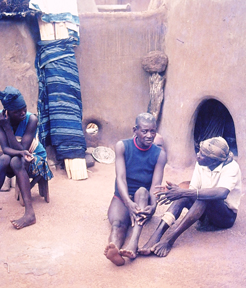
The surviving daughter and guests
(fn 73,110a): Grave and mourning in Bachinsa: On 15 August 1973 Leander’s matrilineal uncle died in Bachinsa and was buried in the cattle yard on the same day. On 16 August 1973 at about 9 o’clock Leander and I visited the compound. All we could see of the grave was a heap of earth (photo). The daughter (wife?) of the deceased and 5-6 mourners were sitting in a courtyard, wailing. But there was also laughter. When the wife left the place wailing, she was held by two women. Behind the women was the death mat leaning against the wall. When I wanted to take a picture of it, I was asked to wait until they had put a cloth around it in the middle, as it should always be with death mats.
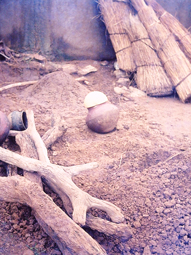
Grave of the deceased man
A little time later, one of Leander’s wives also paid a mourning visit to the house.
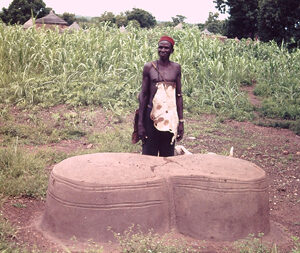
Two tombs in Zamsa
Graves in Zamsa, Avarisi Yeri (fn 78, 3b): Between the road and the present house is a guuk consisting only of a flat mound. There are two bogluk-like, stone-less tombs of Avarisik and his first wife there, which had been built earlier inside the present guuk.
3.5 Burial of infants
3.5.1 The example of Akanchainfiik in Anyenangdu Yeri, Badomsa (fn 88, 62–63)
On 12 October 1988, Ajadoklie, a daughter-in-law of the compound head Anamogsi, called me to her quarters. Her young daughter Akanchainfiik, about one year old, was breathing very heavily. What particularly worried her mother was that she would not accept the breast, although she did not refuse clear water. I took Ajadoklie with her child tied to her back to the Catholic clinic in Wiaga by mobilette. The nurse diagnosed them with pneumonia and was angry that people with such a serious illness were late in coming to the clinic. Despite a course of therapeutic treatment that consisted of two injections and appropriate medicine for home use, Akanchainfiik’s father, Akanpaabadai, reported to me the next day that his daughter had died.
In Ajadoklie’s room (dok), older women of the compound and the neighbourhood (Agoalie, Asiukpienlie and others) held the dead child in their arms. There, I examined her heart and pulse beats, but the child was dead. Akanpaabadai, her father, was despondent, but Ajadoklie was already working again. Male neighbours (ko-bisa) gathered outside the room: Atupoak, Ansoateng, Atinang, Gariba, and others; later, Anamogsi’s elder sons also joined them. Ajadoklie’s room and her courtyard were quiet because mourning was not allowed. The gravedigger Ansoateng led me to the tampoi with two helpers and Anamogsi. After they had quickly made a simple dachoruk (spade), they began to dig at the edge of the compound’s tampoi (rubbish heap). Anamogsi halted their work because he wanted to build a kusung here later, so they looked for another spot. The grave was deepened with the dachoruk, and the earth was removed – first by hand and later with two calabash bowls.
Two old women from the neighbourhood brought the child in a small, tattered child’s mat (ta-chiak) together with a bunch of leaves (wogta?) to the rubbish heap (tampoi). If Akanchainfiik had had a younger sister or brother, she would have been buried by the footpath to Ajadoklie’s parents’ house.
Akanpaabadai (the child’s father), Anamogsi, and some others were sitting about 50 metres away at the compound wall (endnote 43) when Ansoateng deepened the hole at the tampoi to about 50 cm with his spade (dachoruk) in a spur of the rubbish heap. He tore all the bracelets, amulets, and the waist cord from the child’s body (endnote 44) and laid them and the leaves beside the grave. Next he performed some manipulations on the child’s fingers, purportedly ‘to keep them soft’, but I could not discern the genuine reasoning for this (endnote 45).
Ansoateng later told me that he had placed fibre bands on the child (not seen by me) and taken off the bangles because the child was perhaps a reincarnated ancestor (fn 64,4b). If the child comes to the ancestors with bangles, the parents will be in trouble.
Ansoateng placed Akanchainfiik in the grave so that her head faced south, her face east. Her legs were crouched (in an embryo position, perhaps), and Ansoateng placed her hands on her ears. This is also the burial position for adult women. Then, he turned the child around so that she was facing west [Did he make a mistake at first?]. As Ansoateng told me later, such a child’s face must never be directed upwards, and their navel must not be covered with earth. Next to the corpse, Ansoateng placed a piece of an old mud wall, which perhaps only served to fill the grave. He then refilled the remaining cavity of the grave with loose earth, which he tamped firmly with the handle of his dachoruk. He broke the burial calabash with his feet and laid the shards next to the grave, together with the handle of the dachoruk, the small straw mat, and the removed hand, foot, and hip cords. The shards of the calabashes, the hoe handles, the dachoruk, and the mat were placed to the west of the grave; the two blades were later brought into the house. The torn cords and the leaves lay to the east, next to the grave. Everything was lightly covered with earth.
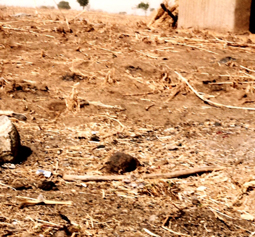
Akanchainfiik’s grave (the dark laterite stone with the handle of the dachoruk)
An assistant fetched a large laterite stone, which Ansoateng placed on the grave after moving it in a circle over the grave four times (yulim v.). The three men washed their hands, arms, and faces directly over the grave; Ansoateng also washed his legs and poured the rest of the water on the grave.
Having done his work, he conversed with the male relatives at the compound wall, who probably thanked him.
At 11:15 a.m., Akanpaabadai visited me and brought me the cooked wing of a rooster and, in the afternoon, brought another chicken’s meat and seven eggs. These gifts were regarded not only as thanks for the trip to the clinic but as an acknowledgement that I had ‘helped’ with the burial (by my presence?).
After Akanchainfiik’s death and burial, mourning was not allowed, as there was a possibility that the mother’s baby would otherwise be reborn and leave her again by dying. Akanchainfiik would thus not receive a funeral celebration.
After the burial, Ajadoklie’s head hair was shaved off in her quarters, in a ritual that I did not observe; Ajadoklie always wore a headscarf afterwards. Perhaps this hair shaving (ponika) was connected to the gaasika ritual (endnote 46).
3.5.2 Further information on the deaths and burials of infants
Some of the information R. Schott and I received about the burial site of an infant is contradictory. For example, R. Schott learnt in Sandema that the first of a woman’s children to die immediately after birth is buried on the way to the mother’s parents’ house and the second in the rubbish heap. All of a woman’s subsequent children who die are buried in the cattle yard (cf. Kröger 1978: 60).
In Leander Amoak’s family (fn 73,331b), several deaths of small children occurred. The first daughter of his first wife, Maami Atigsidum, died when she was one year old; the second girl died immediately after her birth. Both were buried by the footpath to their mother’s house. The first child to die a short time after birth is usually buried in the tampoi, but Atigsidum’s first daughter was already too old for this burial. The afterbirth, which emerges a few hours after birth, is always buried in the tampoi, as are children who die early, up to the age of about 6 months.
Two of Leander’s sons, George and William, died very early in hospital and were buried there. Leander only took some soil from their grave (in Sandema) and some clothes scraps and buried them outside Asik Yeri near the tampoi. His mother’s former matchmaker (san-yigma) shaved her head hair in his house, where she also stayed for three days (representing the male principle). Then, the san-yigma had flour ground, and Leander slaughtered a guinea fowl. The woman could eat this food in her own house (fn 73,331b; cf. also Chapter 3.7 on ngarika burials).
The rites were similar when the daughter of one of Leander’s sons died. The child was brought to the grave in a small, torn sleeping mat (ta-chiak) and buried by four gravediggers. Again, the mother’s san-yigma (matchmaker) took her to his compound for three days. There, her head was shaved, and the gaasika ritual was performed (Fb 2005, p. 37).
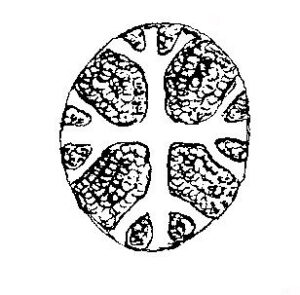
Hair pattern according to Akaosisi
According to Akoasisi, my informant from Siniensi, a mother’s head hair is shaved off after the death of her first child; after the hair has grown back a little, only a partial shave (barisika) in the form of a cross occurs (fn 73,295b, endnote 47). Some of my informants from Wiaga had heard of this shaving in the form of a cross, but they and I have never been able to observe its application directly.
In the family of the soothsayer, Akanming, who lives in Badomsa but is originally from Siniensi, infants are buried in the cattle yard . A large stone is placed on the grave (fn 86,28a). Akanming and his wives will be buried in the dabiak of the senior wife near the divination room, and their children will be in Akanming-Guuk (100 m next to his 1988 Badomsa residence).
Throughout Bulsaland, a child who dies immediately after birth does not receive a funeral celebration if the mother has not yet given birth to another child.
3.5.3 Rebirth of infants
Among the Bulsa, there is a firm belief in the rebirth of infants, which is especially proven when a mother’s children die in succession shortly after their birth. The belief in the general rebirth of adults is not widespread and is doubted by many. However, a child who strongly resembles the deceased grandfather is often considered to be the reborn grandfather.
An informant of mine from Zuedema, Ayarik Kisito, told me (fn 73,300) that a woman in his grandfather’s house had several children die shortly after birth. After another of her births, a married daughter of the house (yeri-lie) laid the child on the tampoi and spread some ashes on the child’s head. Afterwards, the child would not die as part of this rebirth process. In Zuedema, they also twist a finger (endnote 48), a toe, or a leg of a dead infant. A newborn child will display these marks.
According to Ayarik Kisito (fn 73,300), the rebirth of elderly people is also possible. When a popular older man died, some white ash (buntuem) was placed on his hair. A boy reborn afterwards had white hair in the middle of his skull, while the edges were black, just as the ashes had been placed on the old man’s head. A finger, toe, or leg is also twisted on a dead infant in Zuedema. People can check whether the next-born infant was reborn by assessing them for similar deformations. All this is driven by the desire for knowledge about rebirth, not due to therapeutic value.
Margaret Arnheim reports similar measures with slight variations from Gbedema (fn M, 1978ff, 15a+b): A reincarnated person is called kpi-le-ngman-jamdoa (literally, ‘dying and reincarnating’). When a child dies for the third time, the following alternative procedures are performed on him:
1. One toe is pushed over the other.
2. A toe is broken and bent inward.
3. Red clay (junung) is smeared on the part of the arm, thigh, or face. Upon their rebirth, these areas will be lighter.
4. The hair on the head is pulled out in one place. The child is then reborn with a bald spot.
5. White ash is placed on a part of the hair of the head, which, after rebirth, appears as white hair.
6. The upper part of one ear is bent over.
If the child is reborn with the described body deformities, one usually does not give them an additional derogatory slave name (Margaret: ‘It would be too much!’). Before a woman has lost her third child, she should not cry – otherwise, the child thinks it is very desirable and always returns. After the third child’s passing, she may wail and cry because the mutilations are considered efficient. Margaret’s mother knows of no case where a woman has had another child die afterwards. When an unborn child is forced out of the womb of a mother who died in childbirth (see 3.3.3 above), one looks to see if the child has the ‘marks’ or mutilations in question. If this is the case, this was the cause of death for the mother and child; the child would have had no possibility to ‘return’ after birth.
For example, when an old inhabitant of a compound dies, the subsequent birth of a girl or boy is considered his rebirth if there is some resemblance. In that case, the child does not have to perform hard work in the fields and must not be severely punished physically. The child will die at the same age as the old man did.
Pregnant women do not want a man of advanced age to pass behind them because they could easily give birth to this man again after his death. Reborn children die easily and are then reborn again. They may also change sex with each rebirth. Living old men can also be associated with newborn children.
Gabriel, Margaret’s cousin, once mentioned that a specific living person resembles a dead person. Such a statement is not allowed. It is even considered impolite to mention the resemblance of two living people when both are present (Margaret, fn M29).
If a child with no resemblance to a deceased person is insulted or beaten yet is told that they are a reincarnated ancestor, a misfortune (e.g. the onset of an illness) occurs. The diviner then discovers the child was a reborn ancestor (Margaret, fn M34).
The most common way of trying to prevent reborn children from dying is to cut certain scars on their faces and other parts of their bodies (bia-kaasung mobka, ‘evil birth cutting’, cf. Kröger 1978: 128–132, with ten illustrations of bia-kaasung scars).
Often, the tribal scars of another tribe are cut into the child’s face. The child is also named after this tribe, such as Amoak (Mossi), Ayarik (Yarissa), Azangbiok (Haussa), Akanbong (Akan), Ayorik (Yoruba), or Afulang (Fulani). The child can also have the scars of a slave cut and is then called Ayomo (endnote 49).
The symbolic sale of infants born after several babies have died early does not seem traditional among the Bulsa. However, Margaret Arnheim (fn M59b), knows of a case from southern Ghana where a Bulsa woman from Gbedema apparently sold her child to a Zambarima man. The child was given the name Azambarama. The apparent abandonment of the baby in the bush (sagi) also seems to have occurred sporadically in more recent times. In such cases, the child is named Asage or Asagelie. However, Margaret also suspects this custom was adopted from other ethnic groups in southern Ghana.
According to Achaw and others, all these measures assume that the reborn child was an evil spirit (Achaw, fn 73,4b) or that the child would be taken again and again by an evil spirit. The body mutilations, the scars, derogatory names, a feigned abandonment on the trash heap, pretending that the child is not wanted in the human family, and even the sale of the child are all intended to prevent a malevolent power from recognising the child.
While some of the rites described here suggest that one does not wish the same child to be reborn, I received statements from mothers that they desire their deceased child to be reborn in a new birth. This is also supported by information from R. Schott (1966) that the first of a woman’s children to die is buried outside of the outer wall of the house close to the mother’s kitchen (gbanglong) so that the woman can easily give birth to it again.
3.6 Death and the burial of a kikiruk
Preliminary remark: Kikita (pl.) are usually malignant bush spirits in human form. External characteristics of a kikiruk are physical peculiarities, e.g.,s small stature, an unusually large head, an abnormal number of toes or fingers, prematurity, harelips, and other deformities (cf. Kröger 1978: 57–58). Twins, too, are usually considered kikita, although there is uncertainty among some informants as to whether harmless twins are also kikita. After all, even harmless and older twins are buried away from the compound in a secret place inside a gusunguri (black driver ants) hill. In the case of late death, however, their status as kikita does not influence the celebrations of funerals (Anamogsi, fn 102,16a and Leander, fn 73,98b).
All data in the following list refer to the only kikiruk burial I observed in Wiaga-Sinyangsa on 17 April 1989 (fn 88,260+262 and fn 01,12b).
After a twin birth in Sichaasa, one of the babies refused to drink at the mother’s breast, which identified him as a kikiruk. On 17 April 1989, the child’s father came to Anamogsi and bought medicine to encourage the child to accept the breast. After taking the medicine, the child died (endnote 50). This was the final and clear proof that the child was a kikiruk. The father asked Anamogsi, the yeri nyono of Anyenangdu Yeri, to bury his son, who, however, was afraid to conjure up misfortune in his compound. He visited several gravediggers to persuade them to do the job, but they all had the same fears and refused. My willingness to bury the child was not a solution because, as a member of Anamogsi’s family, I would have practically carried out the task for him with the same consequences. Anamogsi finally had to take on the task himself.
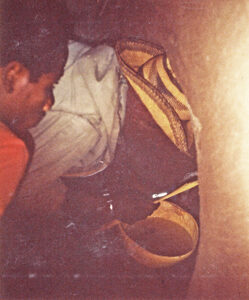
(on the right) The calabash with the kikiruk-medicine and the sie-broom
At around 9 p.m., three of Anamogsi’s sons and I went to the Sichaasa compound as gravediggers. After short talks in the kusung, we entered the roundhouse (dok), on the floor of which the male baby’s corpse, which had quite a big head and already smelled strongly, was lying on some old cloths. From a large, clean calabash, the eldest son sprinkled the baby and the room with the kikiruk medicine using a sie broom made of a few blades of grass. The father removed the neck cord and selected a black samoaning pot from a pile of vessels. Two sons stowed the child in this pot, head down, and closed it with a kpalabik bowl as a lid.
With this pot and an old hoe with an axe blade attached to the other end of the handle, we four gravediggers and the father moved to a flat ant hill with a crater in the middle, about 100 metres away from the compound. The father withdrew immediately after showing us the mound.
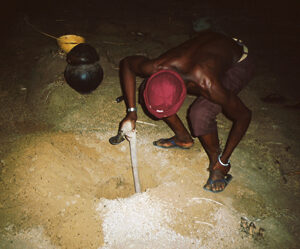
Digging a hole in the ant hill with the dachoruk
The gusunguri (black driver ants) use their sharp cutting jaws to make tiny cuts in the human skin that hurt little and are not reddened or inflamed. Only a tiny drop of blood comes out of the skin. The ants should completely destroy the child’s body as quickly as possible.
The three young men chopped up the hill, first using the hoe, then the dachoruk (at the other end of the hoe), and dug a hole into which the samoaning pot just fitted. With the axe blade, they made holes into two sides of the ceramic pot and the lid so that the ants could enter the pot more easily. Then, they sprinkled medicine water on the pot and the entire grave again. The four of us washed our hands, feet, and faces with the medicinal water. The thin broom remained on the grave. At the father’s compound, some speeches were made again. Then, as official payment, we took the following animals and objects home: a goat, a small dark chicken, the combined hoe and spade (dachoruk), the calabash (from which sprinkles were made), and as a voluntary gift, another sprinkled chicken.
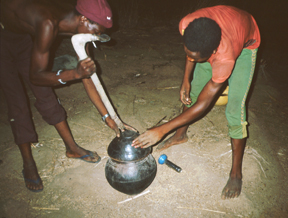
The men use the axe blade to punch holes in the ceramic pot.
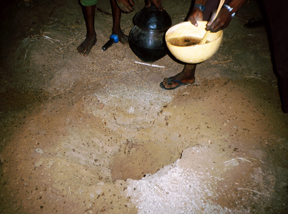
Sprinkling medicine water on the grave
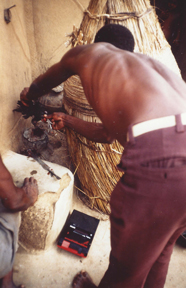
Sacrifice to Anyenangdu’s wen
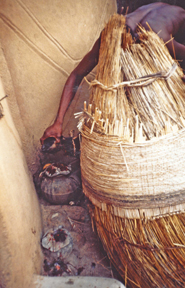
Sacrifice to the kikiruk medicine
On 19 April 1989 at 5:10 p.m., Anamogsi, through his son Akanpaabadai, first sacrificed the additional donated chicken over the wen shrine of Anyenangdu and its knobbed medicine pot. He then offered the blood of the dark chicken and goat to the kikiruk medicine (see photo). Akanpaabadai placed the goat’s neck rope – smeared with blood – and a piece of its tail on the bloody sacrificial spot. Another son cut up the goat with a cutlass on an upturned mortar, and some young boys immediately roasted the goat’s intestines and testicles.
At 5:40 p.m., the medicine shrine received the prepared liver and some meat from the goat. Afterwards, the four gravediggers (Akanpaabadai, Abiisi, Atoa, and I) drank from a very small calabash of the kikiruk medicine, which had no aftertaste. Other participants may also drink this watery medicine (endnote 51).
3.7 Ngarika: Burial of a person deceased in a foreign area
3.7.1 Ngarika in Achaab Yeri, Badomsa (endnote 52)
The following chapter was previously published in English in the journal BULUK 9 (2016: 53–62) under the title: ‘Returning Home as a Dead Man – The Bulsa Ngarika Burial’ and as an article on the Academia website (academia.edu). It is reprinted here with some abridgements and minor changes.
I could only observe a full ngarika with all its details and document it through photos in Achaab Yeri (Wiaga-Badomsa) in 2005. According to instructions from a diviner, the burial of someone who may have died long ago in Chana (Apung, from Achaab Yeri) had to be carried out. All the information below refers to this ngarika.
Some ritual acts resemble those of a typical adult burial, so some redundancies could not be avoided. Some additional information from various informants can be found at the end of this description.
I thank the yeri nyono Achaab and Anamogsi. As kpaga (elders), they were the leaders of the rituals. I also thank the gravediggers whom I was also allowed to observe and photograph the rituals considered secret and which were shielded by mats from all others present (e.g. the forming of the clay figure, the kpiak gebika ritual in the ancestral room, the burial of ‘the deceased man’ behind a screen).
3.7.2 Returning Home as a Dead Man – The Bulsa Ngarika Burial
(Fb 2005, pp. 165–182, Buluk 9, 2016: 53–61) …In the following, I will describe the burial of a man named Apung (name changed), who died and was buried many years ago ‘in the bush‘ (sagi po), referring to environs outside of the Bulsa area. For reasons I will clarify below, the man could not receive a traditional burial near his native compound.
When Achaab’s (name changed) younger brother, a compound head (yeri nyono) in Wiaga, died in 2004, Achaab had to consult a traditional diviner (baano) several times. In the divining sessions, it was discovered that the future would bring numerous calamities to Achaab’s family because the burial of Apung, a former inhabitant of the compound, had not been completed. Apung had left the Bulsa area a long time ago and, according to divination results, had died in Chana (the Kasena area). Nobody knew the location of his grave, and nobody in Wiaga had seen him in his lifetime.
One afternoon in February 2005, the inhabitants of Achaab Yeri and many neighbours met in front of the compound. The old men – among them Anamogsi, the kpagi (most senior elder) of Achaab’s lineage section – were the main officiants of all rituals in Achaab Yeri. They discussed the day’s coming events in the kusung (in front of the compound). Most of the women chatted under a big tree, although a few were sitting around the deceased’s rolled-up death mat in the dalong (ancestors’ room). All were served millet beer (daam).
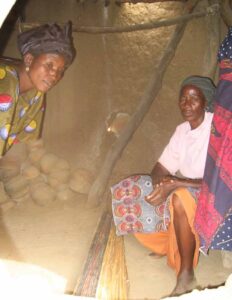
Women sitting around the mat
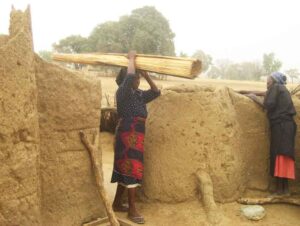
Carrying the mat to the footpath
In the afternoon, a woman, accompanied by some elders, the gravediggers, and most of the other women, carried the mat to a footpath towards Chana, which was supposed to be the deceased’s place of death. After some long speeches, one gravedigger unrolled the mat. Usually, if somebody was buried in a foreign town or village, some dirt from his grave and a piece of cloth containing his ‘body-dirt’ (daung, e.g. ‘sweat’ or ‘blood’) are kept inside the rolled-up mat. These things were unavailable in Apung’s case, so they substituted them with a white cloth provided by Achaab’s people. The gravedigger poured some water on the ground, formed a mud ball from the wet earth, and wrapped it in the white cloth.
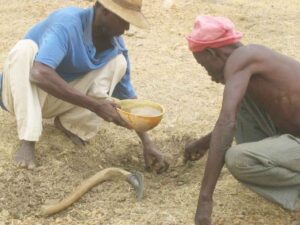
A gravedigger pouring some water on the ground
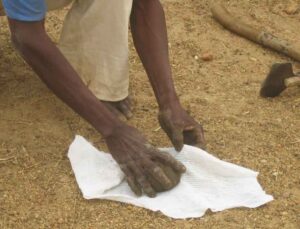
Wrapping the mud ball in the white cloth
The mat, with the mud ball and the cloth inside, was carried to a place near the meeting room (kusung) in front of the compound where the noai-boka ordeal was performed. Usually, this ritual is of very great importance and is carried out with a great deal of exertion since it reveals who among the living or dead was (or were) guilty of the deceased’s death. Here, however, everybody was sure that the mat would not declare one of those present guilty or run with the two gravediggers holding it to the culprit’s house since nobody had known Apung while he was living.
Standing in front of the mat, Achaab asked questions that the mat answered. The mat moving forward via its carriers signified a ‘yes’; conversely, the mat moving backwards via its carriers signified a ‘no’. At last, the kpagi advised Achaab to abridge the procedure. The determination of the questioning was that no living person had caused Apung’s death.
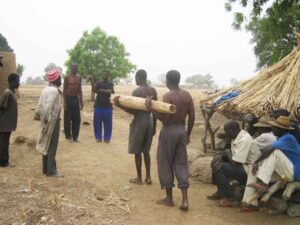
Performing the noai-boka ritual
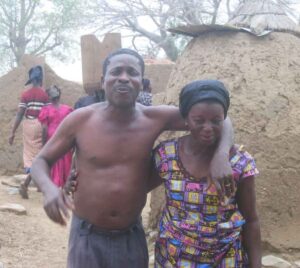
Mourner supported by a women
The mat was carried back to the dalong again, and the general mourning commenced. Male relatives (supported by a male or female friend) and female relatives (supported by one or two other women) all walked towards the mat, shedding ample tears and uttering cries of woe, even though they were distantly related to the deceased. It was evident to all present that they were not genuinely affected by the death of a man whom they had never seen in their lifetime. After this formal mourning ritual was completed, the participants washed their faces with clear water and were cheerful again.
At about 5 p.m., two gravediggers entered the dalong after removing the wet mud ball from the white cloth and forming a human figure out of it. The figure was thereafter regarded as Apung’s corpse.
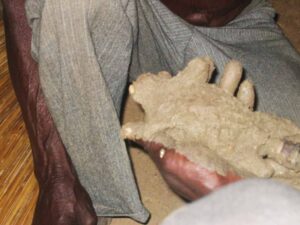
Forming a human figure
3.7.2.1 Digging the Grave and Burying the Mud Figure
Immediately after forming the figure, the gravediggers started preparing to dig the grave north of the compound entrance (nansiung). One of them placed a calabash on the chosen spot and, with his traditional spade (dachoruk), drew a circle around it about 10 cm away. Next, he threw a stone against the calabash three times. The gravediggers could not explain the sense of this ritual but later I learnt that it should certify the locality of the grave.
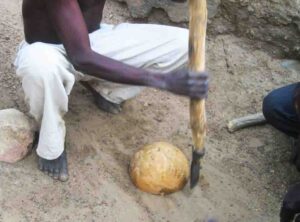
Drawing a circle around a calabash
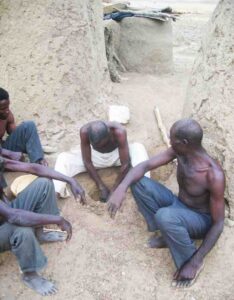
Digging the grave with bare hands
The first phase of the excavation was completed using a hoe blade, a calabash bowl, the dachoruk spade, and the gravediggers’ bare hands. The depth of this mock grave – less than half a metre – did not reach that of an actual grave (more than one metre). At the shaft’s bottom were small indentations of approximately 20 cm. These were used to accommodate the head and legs of the dead body. After it had grown dark, the work at the grave was performed by the light of traditional torches – burning single millet stalks. After the digging was finished, the dachoruk (spade) was placed over the hole to demonstrate that no living being might enter the grave again (which, in any case, would have been impossible due to the small proportions of the shaft and the grave chamber).
Achaab, the compound head, had prepared millet water, groundnuts, a small bag of tobacco, a bottle of akpeteshi (distilled palm wine) and, later, a fowl and a goat for sacrifices and as gifts for the gravediggers.
At 9 p.m., millet water was poured as a sacrifice (kaabka) in front of the grave (endnote 53); afterwards, the gravediggers drank the remaining liquid. Before the chicken was sacrificed, the first gravedigger moved it over the grave hole thrice, killed it by knocking it against the dachoruk spade, and stepped on it with his bare feet. In contrast to other sacrifices, this fowl was not allowed to flutter before dying. The first gravedigger opened three groundnuts and placed the seeds on the ground near the grave, along with a small portion of tobacco. A neighbour killed the goat, which was immediately cut into pieces on a bundle of millet straw. The remainder of the unsacrificed food and drink was given to the gravediggers.
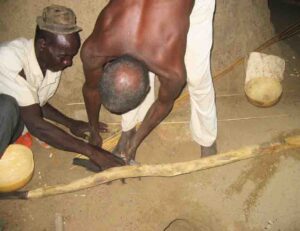
Killing a fowl by knocking it against the dachoruk
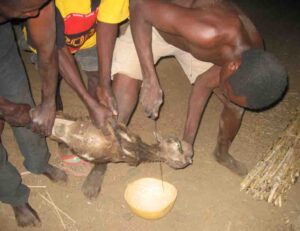
Killing the goat
The ritual procedure could not proceed in Achaab Yeri before they had made up for two omissions at former burials. According to the lakori principle (cf. Kröger 2012), rituals performed in the past may be performed differently in the present, but the additions or changes must be re-performed for the former recipients. Two members of Achaab’s sub-lineage who had lived in neighbouring compounds had died some years before and been buried without receiving the sacrifice of a goat. Therefore, relatives of the deceased left Achaab Yeri with two goats, which they killed over the graves of these two neighbours in their compound. A third goat was killed for some deceased people of Achaab Yeri, including a woman (endnote 54).
When all were back in Achaab Yeri, the kpiak gebika ritual (endnote 55) was performed. I had heard of this ritual before, but none of my former informants had ever seen it. It was top secret – not even close family members were allowed to watch it. After two gravediggers had entered the dalong, the entrance was entirely closed off by the death mat (tiak). Then, one of the two men inside reopened it and asked me to enter. Inside, I was permitted to take photos. One gravedigger took a fowl and removed the shielding mat a little, and a hand from outside caught the other half of the fowl. Later, I learned that the man outside was Achaab and that his eyes had been closed for this ritual by another person’s hand. While the two men were holding the fowl, it was cut in two with a cutlass. By undertaking and completing this ritual, all of the conflicts and annoyances between the deceased and his survivors should be eliminated, with the chicken assuming all guilt and being killed for it. This ritual is secret because the souls of all living persons – especially of the deceased’s friends and relatives – are in danger of being enticed to follow the defunct to the realm of the dead if they witness it.
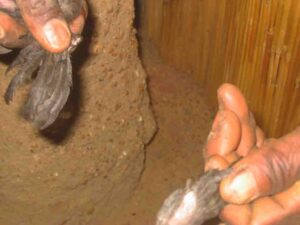
Kpiak gebika: cutting a fowl in two
Later, I discussed with my Bulsa friends why I, a stranger to Achaab Yeri, was allowed to watch the ritual in the dalong. One or all of the following reasons might be applicable: For more than 30 years, I had been a good friend and adopted son of the kpagi, the main officiant of the burial performance, and had received his permission. I was also a good friend of the senior gravedigger, who might have otherwise protested. My position as a stranger to the house might even have been advantageous for me since the deceased likely had no particular desire to demand my companionship in the realm of the dead.
After the rituals in the dalong, the burial proper began.
The mud figure, dressed in a white cloth that functioned as golung, the triangular underwear (endnote 56), and a wooden headrest (zu-kpaglik) carved by one of the neighbours, was wrapped in the death mat. Then, covered with a blue-and-white cloth, it was arranged on the grave. There, the mat was unrolled and situated in a vertical position around the grave to shield the burial activities – which have an esoteric character – against any spectators except the gravediggers and close family members. Three gravediggers and I stood inside the mat fence. One older and experienced man stood outside the mat and occasionally gave some advice or instruction. The mud figure in its white golung was placed in the grave.
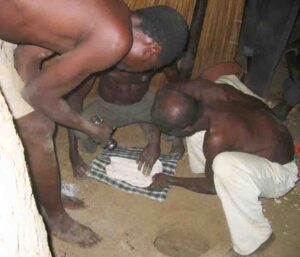
The mud figure dressed in a white cloth
Achaab was called to inspect the grave, give his consent to the work done, and touch the dead ‘body’ (the wrapped-up mud figure). He threw three handfuls of earth into the shaft and added a large white smock (garuk). The grave cover, a ceramic vessel (chari), was pierced so that the soul of the deceased could freely leave and re-enter the grave on excursions such as residing in the death mat. Achaab moved (yulim) the ceramic grave cover three times over the grave in a circular fashion before it was fixed over the shaft. The man outside the mat fence objected to how the white smock had been folded before it was placed into the grave; it allowed the soul of a living person to hide in it and join the dead man. The smock was removed, unfolded, refolded, and returned to the grave shaft (endnote 57).
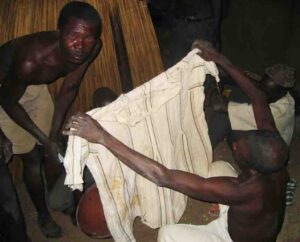
The white smock before its burial
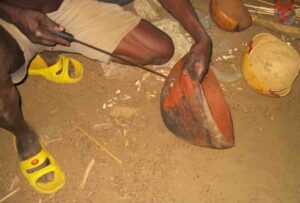
Piercing a hole into the ceramic bowl
Before they started throwing earth into the grave, the first gravedigger put his foot in the grave to prevent the earth from intruding into the ears and eyes of the ‘dead body’. The earth in the grave was pressed with the upper end of the spade (dachoruk) to prevent the grave from sinking in later. The ceramic vessel (boosuk), which had some sand in it, was placed on a small mound of earth over the grave. The hole in the vessel, filled with a splinter of a millet stalk (ngmeeni) to prevent earth or dirt from intruding into it, had to be placed facing the east. One gravedigger sprinkled water on the boosuk vessel, plastered it with wet mud, and drew a cross in the wet plaster with one of his fingers (here, not regarded as a Christian symbol). Washing their hands (as part of the ritual) and placing the long handle of the spade (dachoruk) and the calabash used for sprinkling water beside the grave marked the completion of the gravediggers’ activities at the grave. The spade’s blade was kept at the main entrance (nansiung) of the compound; the mat, covered by a blue cloth, was placed in the main courtyard (dabiak) in front of the ancestors’ room (dalong). Its thinner end was on the ground, a placement strictly forbidden for mats without a ritual context. It is now no longer called tiak (a sleeping mat) but ta-pili (a rolled-up mat).
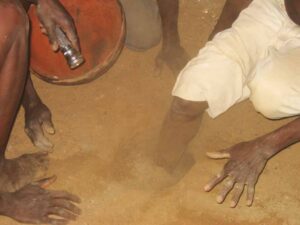
A gravedigger is putting his leg into the grave shaft
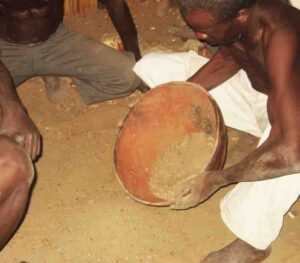
The ceramic vessel with some sand in it
3.7.2.2 Ta-pili yika (hanging up the mat) and nyiinika (smoking)
Three days after the burial, the ritual of ‘hanging up the mat’ (ta-pili yika) occurred in the late afternoon, as it is the general custom among the Bulsa. While the mud figure represented the deceased man during the burial activities, it was now the mat, wrapped in the middle with a blue-white cloth, which symbolised the dead person. The destination of all condolence visits was and would be the mat, not the grave.
After the obligatory speeches in the kusung, two bare-chested gravediggers took the mat, which had been standing in the inner courtyard in front of the ancestors’ room (dalong) for the preceding three days. The gravediggers prepared the rolled-up mat containing the wooden headrest (zu-kpaglik) for the ta-piili yika (hanging up) by wrapping an untwisted fibre around it. Achaab, the compound head, was only a spectator and had no functions in this ritual. The gravediggers carried the mat into the dalong and fixed it under the roof beside the mat of another deceased person in the compound. The untwisted fibre strings would perhaps later be replaced by nylon strings or wires to make them termite-proof. These mats are used for various rituals during the funeral celebrations and later burnt on a field outside the compound.
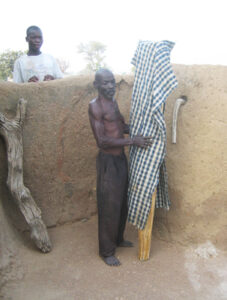
The dressed mat and one bare-chested gravedigger
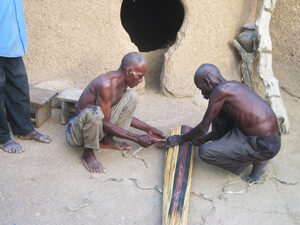
Wrapping untwisted fibres around the mat
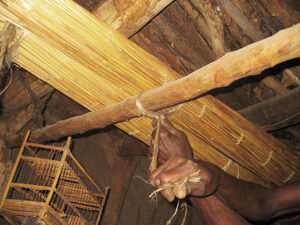
The mat under the roof of the dalong
After the ta-pili yika ritual, the gravediggers went to a place near the compound’s entrance. They started a fire in a bowl (kpalabik) for smoking (nyiini) things that had been used during the burial and still contained the smell (piisim) of the ‘corpse’ (i.e. the mud figure). I forgot to ask what was actually burnt, but on a similar occasion in another compound, the fuel consisted of dried chicken faeces and ngmanyak grass. The objects were cleaned by holding them in the smoke. They included, for example, the blue-white cover cloth of the mat, a ceramic vessel (liik) that had once contained water for mixing the plaster of the grave cover, a calabash bowl (chin), and the hoe blade that had been used for digging the grave. After cleansing them with smoke, these things could all be used for secular purposes again. The long handle of the spade (dachoruk) and one calabash, both of which were still lying on the grave, were not included in this procedure.
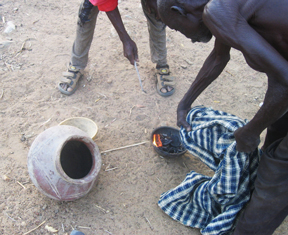
Cleaning the mat’s cloth over smoke
To announce the conclusion of all the burial rituals, Achaab’s son fired some shots in front of the compound not by using an old muzzle-loader but using the specific Bulsa instrument called da-goong. It consists of an iron tube with an ignition hole at one side (about its function, cf. Kröger 2001: 653–54).
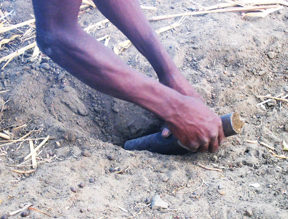
Using an iron da-goong tube for fire crackers
3.7.2.3 Comparison with Ordinary Burials
The ngarika burial resembles an ordinary burial substantially. However, all activities concerning the dead human body are not typically performed or, if included, are considerably reduced. These activities include confirming the death, washing the corpse, shaving the hair, and massaging the dead body to delay rigor mortis (enabling the corpse to pass through the narrow grave shaft and be positioned in the small grave chamber). Some of the other rituals are also altered slightly. The noai-boka of a person who died in the compound can be performed in the cattle yard (nangkpieng). In the kpiak gebika ritual, it is usually the person who had some conflict with the deceased who holds one end of the chicken; here, Achaab probably represented all (living and dead?) inhabitants of his compound. Surprisingly, the activity of digging the grave with all its small rituals is nearly identical across the two burial variations. These similarities include:
– Screening the area by using the death mat
– Throwing small stones against the calabash
– Piercing the ceramic grave cover with a hole (boosuk)
– Circling the boosuk before placing it on the grave with the hole directed to the east (for men)
– Inspecting the grave, which is performed by the compound head, his eldest son, or both when the gravediggers’ work has nearly been finished
– All details of the ta-pili yika rituals three days after the burial
– Smoking the objects that had some contact with the ‘corpse’
In Achaab Yeri, one gravedigger even tried to prevent dirt from intruding into the corpse’s ears by placing his leg in the grave since the procedures followed during an ordinary burial were not applicable here (e.g. placing the hands of the deceased or hoe blades on his ears). In addition, the practice of smoking certain objects does not necessarily make much logical sense since the mud figure does not emit any smell (piisim).
The cause for including a ritual that does not make any sense in a ngarika burial may be rooted in the great sense of respect for tradition as well as in the fear that discriminating against those who died in a foreign place might provoke their anger and endanger the living.
3.7.2.4 Ngarika Burials in Modern Times
There have always been cases where Bulsa have died outside their traditional lands. In the pre-colonial nineteenth century, when the slave raider Babatu haunted parts of Northern Ghana, many Bulsa were abducted; their relatives never heard from them again. The (ngarika) burials and final funeral rites for some of them have been performed in the meantime, while others are still pending.
Moreover, in colonial times, many Bulsa were recruited for the Gold Coast Regiment; some died abroad in Europe during the First World War. Meanwhile, to earn some of the British money that the colonial power had introduced, the Bulsa people walked (!) to Kumasi and other towns for the opportunity to work in one of the cocoa plantations.
After Independence in 1957, the magnetic attraction of big towns in southern Ghana moved young men to leave their native villages and seek job opportunities or start a life of hard work in one of the gold mines (e.g. in Obuasi). More recently, countries in Europe or North America became attractive, particularly among the educated Bulsa youth. Many of these migrants looked forward to returning to Buluk as rich, respectable men or women. Others – often those married to European or American partners – became so assimilated into their new culture and life that they gave up all plans to return home for good.
All these people were faced with the question of what would happen to their bodies after death. Wealthy Bulsa uttered in their last wills that their bodies should be transported in a coffin by aeroplane to be buried near their father’s compound within a more-or-less traditional ritual framework (endnote 58). Other, less wealthy Bulsa knew that when they died, their descendants could not afford these high transport costs and instead requested that their sons go home to traditional Bulsa areas with a piece of cloth containing the body dirt (daung) and a handful of mud from their father’s foreign grave. These would be used to perform the ngarika burial. Still others were content with only being buried in a foreign country.
A new influence on the performance of burials was exerted by Christianity and – to a lesser extent – Islam (cf. Atuick 2013: 36–42). Devout Christians usually wish to be buried with the rituals of their new religion, and this holds for deaths abroad as well as in Bulsa villages (endnote 59). Double burials are apparently on the rise for people in such a context. A few days after the Christian burial at a cemetery, a ngarika is performed with a cloth and mud from the grave. Even for non-Christians and non-Muslims who die in a hospital (e.g. in Sandema), it may be inevitable that they are buried near the hospital, so the relatives must be content with the performance of the ngarika.
Although the number of deaths outside Buluk will probably increase, it is uncertain whether the ngarika’s quality will undergo changes. Many of the rituals that no longer make sense for a burial without a corpse (e.g. preventing mud from intruding into the ears of a mud figure or smoking objects to remove their piisim smell) may be dropped. For Christians, the ngarika may become only an antiquated custom with a folkloristic character. The idea that the ritual is necessary for a happy afterlife in the company of ancestors may no longer be of any value.
3.7.3 Further information on ngarika burials (not yet published)
Yaw Akumasi, a coworker of mine, provided a general description of a ngarika burial in 1997 (fn 97,9a+b). He wrote his report before I could directly observe a ngarika burial (2005) in Achaab Yeri and the typical burial of an adult (Yaw’s sister, †2003).
If a Bulsa has died in the south, one takes some earth from his grave (in the south) and wraps it in a white or red cloth (endnote 60). When the dirt has arrived in Bulsaland, the bearer group stops at a certain distance from the affected compound (e.g. by a road) and waits there (limsika). The inhabitants meet the group with a new mat (ta-pili) and wrap the cloth with the earth in it. In the open space (pielim) before the compound, the noai-boka ritual is performed with the mat. Afterwards, the death is announced (kuub darika), and the neighbours who did not participate in the noai-boka are informed. Everyone mourns by wailing loudly. At the location where the mat is kept, one takes a stick [F.K.: zu-kpaglik?] with the thickness and length of a forearm and wraps it in a golung apron, which does not necessarily have to be new. If an animal (e.g. a chicken) runs (gaam) over the mat on the ground, this animal also belongs to the gravediggers – supposedly, the dead person wished for this animal. A gravedigger now leads [one after the other?] some children and brothers of the dead person [F.K.: who had a conflict with him during his lifetime] into the mortuary, covering their eyes. One fetches a small chicken, which both the relative(s) and a gravedigger hold. Another man cuts it in two with a knife (kpiak gebika). All evil – for example, conflicts with the dead – is then within the chicken (kpa-gebing), which is not eaten but thrown away.
Before digging the grave (vorub tuka), the gravediggers are given a chicken (ta-pili kpiak = chicken of the mat), a guinea fowl, a goat or a dog whose meat belongs to them.
The grave widens in its lower part but does not reach a great depth (e.g. one foot). When about half of the digging is completed, the women of the house present millet water to the gravediggers. If they also give a goat or a sheep, its meat belongs to all [gravediggers?] present.
After the grave is finished, the gravediggers carry the mat, along with the earth and the stick with the golung (apron), to the grave. There, everything but the mat is buried. The mat is placed upright (sali; literally, ‘to lean against’) with the thick end down in the courtyard before the mortuary. It remains there for six days if the deceased is male and eight days if a woman (during rain, the mat may be brought indoors). This practice should let everyone observe that this is the place of the dead person’s origin. On the sixth (or eighth) day, vayaasa come and tie white fibres (bog-pieluk) of the kazagsa plant around the top (zuk: ‘head’) and bottom (jiuk: ‘tail’) of the mat and then take it to the dalong (or dayiik or another room) where it is hung under the ceiling (tiak-yika: hanging of the mat). It remains there until the funeral celebration.
A deceased child with no younger siblings (biik basika: ‘child who has abandoned parents’) is given only a small, torn mat (ta-chiak) for their ngarika burial, which is thrown away after the burial of its contents. Accordingly, there is no tiak-yika ritual.
A ngarika burial also plays a role if, a long time ago, a man disappeared (e.g. in the slave wars), and it is unknown whether he is dead. Such a case has been reported by Leander Amoak (fn 79,18a).
Abonwari (Leander’s FB, see also genealogy, Appendix 4.1) had been missing since the slave wars at the end of the nineteenth century; perhaps slave raiders captured him. As late as the 1970s, it was unknown whether he was still alive. If so, he would still be yeri nyono of the compound, and all sacrifices could only be performed vicariously for him. (fn 79,30b): Nevertheless, Leander’s father, Asik, was the official yeri nyono of Asik Yeri during his lifetime. He performed sacrifices to all the ancestors because he had once established a compound in Sichaasa and then rebuilt one in Badomsa on the site of the old compound. At the new compound, Abonwari was no longer yeri nyono. When Asik died, he was given a proper funeral, as it was assumed that Abonwari was still alive. Asik’s eldest son, Atiim, also sacrificed on his own. Leander is not allowed to sacrifice because the funeral celebration of his late brother and predecessor, Atiim, has not yet been held. However, this can only be performed after Abonwari’s funeral. They will probably be held shortly after each other. Abonwari’s funeral celebration has still not been held as of 2023 due to fear of evil consequences (fn 79,35). Before important events, such as the re-erection of the ancestral shrines on 20 July 1979, Leander went to the compound and informed Abonwari that a particular ritual or celebration was now happening. This involved standing in front of the kpilima dok and speaking into it.
When Leander suffered a serious eye disease (in the late 1960s?), he went to a diviner for advice. This man ascertained that Abonwari was dead and that the pending burial was the reason for Leander’s eye disease. Leander’s elder brother, Atiim (the yeri nyono), thus took some earth from the Atekauk plot (earth: the body of the dead) near Asik Yeri, wrapped it in a cloth and spread it on Abonwari’s sleeping mat. Before entering the house with the mat, Atiim wanted to learn the reason for the death through the noai-boka mat ordeal. Among other things, he said: ‘You are now a dead person. Did Asik [Leander’s father] cause your death?’ The mat stopped (signifying a no). ‘Did one of Asik’s children cause your death?‘ (no!) ‘Was it your own fault?’ The mat ran to the kpilima dok, where Abonwari’s shrine (bogluk) stood. The elders stopped at the entrance. After repeating the noai-boka, the mat came to the same conclusion. Then, from Abonwari’s mat, the cloth with earth, one cap, one smock (garuk), one triangular cloth (golung), and one hoe blade (‘to put on his ear’) were each buried (F.K.: Earlier dead of the compound were likely buried with these grave goods). In the courtyard, a cock (kpiak vorub) and a sheep were slaughtered for the vayaasa (or ve tuerisa, ‘grave diggers’).
Abonwari’s two living daughters continued to visit Asik Yeri. However, they did not eat any sacrificial dishes because their father, whose funeral celebrations had not yet been held, was supposed to be the head of the household.
Sometimes, a ngarika burial also helps prevent or defuse conflicts between a married woman’s parental home and that of her husband (Yaw and Anamogsi 2005, Fb, pp. 5 and 9).
Shortly after she had moved out of her husband’s compound, Anamogsi’s wife, Agoalie, died at her parents’ home in Sandema-Nyansa (December 2004) and was buried there without any participants from her husband’s compound in attendance. A few days after the announcement of her death (darika), a group from Anyenangdu Yeri appeared in Nyansa to mourn. Since Anamogsi wanted to hold their funeral celebration, he procured soil from the grave in a calabash bowl and some clothes from the Nyansa compound (probably through his wife Ayabalie, a relative of Agoalie) without official permission but the tacit acquiescence of the Nyansa people. Since this act was clandestine and unauthorised, persons from Nyansa could not come to the ngarika burial at Anyenangdu Yeri, which occurred two to three weeks after her death and without Anamogsi attending it. Agoalie’s grave earth and a garment were buried in a ngarika burial at Aluechari Guuk, a former residence of Anamogsi’s late father’s father, under a gaab tree. Representatives of Nyansa came later for the funeral celebration after Anamogsi had paid some ‘animals’ (dungsa) to the Nyansa compound for the trouble of the burial. There was and remains no dispute between the two compounds. The noai-boka at the burial site with the mat from Nyansa revealed that Agoalie was to blame for her own death because she had not properly announced her departure (Fb 2005, pp. 5 and 9).
The death of Akanming’s granddaughter (fn 88,231b and 88,202b): On 13 March 1989, Akanming’s eldest son, Anamnya Johnson, came from the south to report the death of his eldest daughter, Comfort (born in 1970 and a student at Awasa Business College). He brought underwear (pants) and soil from the southern grave. These were buried along a footpath on the north side of Akanming Yeri by the gravediggers, Asaaluk and Ansoateng. When I visited the burial place, a liik pot used for fetching water to mix the soil for the tumulus, a coarse dachoruk handle, and a medium-sized calabash were each lying beside the tumulus. (Per my informant, Danlardy: These things remained there for 4 days and were then destroyed). At the entrance to the compound, the dachoruk and hoe blades were lying on the ground. On 17 March 1989, only the dachoruk and the hoe handle remained at the grave. The two blades were then lying under the thatched roof of the small kusung-dok (cf. fn 202b).
The account of a ngarika from southern Ghana given to me by Ayarik Kisito (fn 73,311b) has some differences to what has been described so far: When someone has died at a foreign place, they bring home their mat and their personal belongings; the bearers also paint their faces entirely or only with a ‘mark’ on their left cheek with earth colours.
3.8 The noai-boka ritual (endnote 61)
Preliminary note: This pivotal ritual has been mentioned several times in the preceding text. The following completely reproduces the information I have available, which should also show that the ritual is practised in large parts of Bulsaland with minor local variations.
In a noai-boka ritual, the yeri nyono or another person of advanced seniority tries to discover the deeper cause of a specific death by posing (endnote 62) questions to the death mat. This ritual can be performed at various points in the ritual sequences after a death, even years later. It can also be performed (again?) during the later funeral celebrations of the dead, often in an abbreviated form.
Usually, this ritual occurs shortly before the hanging of the mat (ta-pili yika).
3.8.1 Information from Wiaga
3.8.1.1 Noai-boka after a fatal accident
Yaw Akumasi gave me details of the noai-boka rituals and other methods (e.g. earth drinking, divination) to find the one guilty of a certain death. The following sub-ritual with a pebble seems to be quite common in Wiaga and other villages and towns (e.g. Sandema).
If he cannot find the guilty person in a noai-boka ritual on the first attempt, the questioner takes a stone into his left hand and mentions one name in a low voice, as he does not want to annoy that person in public. Then, he throws the stone in the direction of the standing mat. If the mat comes forward (representing a ‘yes’), he does not publicly mention the name. He goes to the soothsayer to learn the truth. If the soothsayer confirms the questioner’s suspicion, the performer calls all the ko-bisa and the ‘killer’ before hanging the mat (fn 01,36b).
If the accused admits the findings of the mat, he must make certain sacrifices. If he denies it, some earth is taken from the deceased’s grave, and drinking of this earth (vorub tengka nyuka or boosuk tengka nyuka) is arranged (endnote 63). Such a drink of earth-water can kill an entire house. If the suspect is innocent, the yeri nyono will die; otherwise, the suspected murderer will. If the latter confesses, he must swear that he will never kill another person.
(fn 11,8a) If one knows the cause of death through a soothsayer, no noai-boka is held.
(fn 88, 230 +b) The death of the young man Agaam (name changed) has already been mentioned in connection with the suurika ritual (cf. 3.4.1.9). He belonged to a section in Gbedema but had been living in Wiaga-Badomsa for a long while. As a member of the Badomsa band of musicians, he performed at a large festival in Sandema on 13 March 1989. Late at night, the musicians and others were taken back to Wiaga by a tractor. Agaam fell off the tractor, was run over by its trailer, and died at once.
At 1:30 a.m. the next day, his noai-boka was performed, lasting about an hour. Akabandoa, the yeri nyono of Agaam’s compound, stood at the compound entrance and asked the questions. At first, the body was wrapped in the mat, placed about five metres away from the questioner. The mat carriers were Akperibasi, from Abasitemi Yeri; Lamisi and Vitus, from Aniok Yeri; and Aduok, from Apanka Yeri.
Akabandoa called out three to four times: ‘Agaam!’. Then, he asked the following questions:
1. Has any evil followed you from this house? [i.e. Is someone from this house to blame?] – The mat moved back (no).
2. If evil has followed you from another house, come forward (no).
3. Did you have to die because you did not make sacrifices to your parents for a long time? The mat came forward a little (conditional, yes). The corpse then almost fell out of the mat. In response, the mat was laid on the ground, and the corpse was carried into the house and laid on a new mat. The clothes of the deceased were wrapped in the ordeal mat.
4. Akabandoa asked the mat whether he was guilty of his death because of a specific argument he had had with Agaam two days earlier: When Agaam returned from Sandema market with a friend, he talked to some Anyenangdu Yeri people about the planned trip to Sandema, where a new chief of Kadema was elected. When Akabandoa told him not to go to Sandema, Agaam became angry. In response to this query, the mat came forward a little.
After this, Akabandoa said, ‘Anamogsi, ya bu wom’, and Anamogsi (the kpagi) asked the questions from then onwards. (Perhaps the change happened because Akabandoa had been implicated in the guilt for Agaam’s death by the fourth question).
Anamogsi asked:
1. Has an evil followed you out of this house? – The mat moved back (no)
2. The drummers’ group often came to Anyenangdu Yeri. Anamogsi had told the musicians that they could eat and drink in any courtyard, so if one of Anamogsi’s people would be to blame for the death, let the mat knock him (Anamogsi) down. – (no)
3. Is Agaam himself the reason? (no)
4. Was he magically poisoned in Sandema? (no)
5. Did he eat or drink anything wrong (not in the magical sense) in Sandema? (yes) This answer was probably related to his excessive drinking.
Akabandoa repeated his first two questions to the mat. He then publicly stated that Agaam had been very ill in the last rainy season, and Akabandoa had gone with him to the diviner, who discerned the reason for the illness: Agaam had not sacrificed to his parents’ shrines behind the compound for a long time. Agaam had argued that he did not ‘because they did not procure him a wife’. Akabandoa induced him to sacrifice, and the disease disappeared. After that, however, Agaam stopped his sacrifices again. After asking the mat whether this was the reason of death, the mat moved forward (yes, confirming the statement).
Later, it turned out that his refusal to sacrifice to the tanggbain Pung Muning for not arranging him a wife was also partly to blame for his death.
3.8.1.2 After a conflict
Leander Amoak (fn 79,51a-b) told me about a conflict that had probably occurred in the 1960s before the beginning of my fieldwork among the Bulsa. Angiak and Amaring (both Ayarik-bisa of Badomsa; names changed) had quarrelled and cut off all contact. When Angiak’s sister died, Ayarik’s descendants were all supposed to gather for the funeral celebration (around 1967). Atewen – Amaring’s son – and all the wives of his compound and sub-lineage (Asanduok-bisa) did not attend. However, Angiak, Azuera’s descendants, Akanming and Asik’s descendants appeared at the funeral. This disparity intensified the hatred. Agadila’s wife then died in Anyoripo Yeri (Asanduok-bisa). Angiak was invited to the burial but did not come, while Leander Amoak, the elder of all Ayarik-bisa, attended the ritual. Leander stood in front of the Anyoripo compound and asked the death mat (with the dirty clothes of the dead man inside it) to come out to the noai-boka ordeal so that the funeral could occur. The mat came out, and Leander asked the following questions:
1. If Abonwari is not the right head of the Ayarik-bisa or is still alive and has caused death, the mat should move forward. – It moved back (no).
2. If Azuk, the yeri nyono of Anyoripo Yeri (Asanduok’s family), has offended the ancestor-bogluta, the mat should move. – It moved back (no).
3. Then Leander took a stone, spat on it and asked the following question in his mind (or softly spoke it): If Agadila, the dead woman’s husband, and her stepfather [F.K: father-in-law?] Azuk were the cause of death; the mat should follow the stone that Leander threw away. Thereupon, the mat jumped on Leander and the stone. Leander now told the public what he had thought (or said quietly).
4. Azuk (his stepson was standing next to him) now spat on a (the?) stone and thought (or spoke softly?): Am I the guilty one? The mat came forward (yes). But he did not tell anyone what he thought and why he was the guilty one.
After the ordeal, the body was buried. Four (female number) days later, Leander had to come to Anyoripo Yeri to hang the mat. He stopped at a distance in a field in front of the compound but refused to come closer, although Azuk had sent for him. He stated that he refused because Azuk had not told him what Azuk had said to the stone in a low voice. The mat was then hung by householders but not officially by Leander. This is how Leander got involved in the dispute. Shortly afterwards, Atewen’s stepson died (Atewen was still alive). Leander did not go to the burial; they performed all the rites without him. Then, Achang died (in 1975?). Leander did not attend the funeral; later, Atewen died (in 1976?). Leander was invited to the funeral. Since Atewen had done much for the Ayarik-bisa, Leander went to Abapik Yeri and asked them to attend the funeral. They agreed. [F.K.: Since the oldest ancestral shrines of Badomsa were in Abapik Yeri, the whole of Badomsa had to come]. Leander also went. When, after three days (for a male dead), the mat had to be hung up, Leander refused at first as he wanted to know the reason for the death of Agadila’s wife. Azuk took Leander out of the kusung and told him the true story [about his guilt] apart from the others.
In 1978, when I shifted the focus of my fieldwork from Sandema to Wiaga, the dispute was wholly settled.
3.8.2 Information from Sandema
3.8.2.1 Description by Godfrey Achaw from Sandema-Kalijiisa (fn 73,44a+b+45).
The eldest son of the dead man stands nude in the main entrance, facing the inside of the compound. Meanwhile, two naked men bring out the mat on which the deceased passed away. The eldest son questions the mat. If the person named in the question killed him, the mat advances (signifying a yes); if not, the mat moves back. The bearers can also be driven to the house of the murderer. There, the two bearers jump with the mat over the inner wall into the murderer’s yard, and the front of the mat pushes the murderer down. Relatives of the dead person have sometimes even tried to kill this ‘guilty’ person if others did not intervene (Godfrey heard this only from others and had not directly experienced it).
The following questions, among others, can be asked by the eldest son:
1. Is it I myself who caused the death?
2. Is it someone from the house who does not love you?
When a yeri nyono has died, his successor also stands naked at the entrance. If the mat does not find the murderer and returns, he remains standing at the entrance while the eldest son returns inside the house. The successor asks:
3. If I am the cause, strike me down.
4. Have foreign wives [F.K. married-in wives?] from other villages been seduced by someone there?
5. Was it the dead man’s fault that the ancestors took him?
6. Was this a natural death?
(The order of questions 2–5 is not fixed). After the cause of death has been found, mourning is allowed.
3.8.2.2 Excerpts from Aduedem’s unpublished study (2019, Chapter 1.1.1, p. 6f)
Typically, the dressed corpse will sit alone at the far end in the ancestral room (dalong), facing the entrance (endnote 64). The straw mat it [the corps] was lying on is folded [rolled up?] and carried out by two half-dressed (endnote 65) young men (endnote 66) from the extended family or clan. When these men reach the cattle kraal (nangkpieng), they stop. Another half-dressed male delegated by the family – a son (endnote 67) or a relative – who the elders have instructed will meet the mat near the entrance. He introduces himself to the mat by mentioning his name and saying he is there to discover the cause of his death. Usually, if the mat advances via its carriers, this signifies a ‘yes’; the mat moving backwards via its carriers signifies a ‘no’ (endnote 68). The description below illustrates the noai-boka of a person whom witches killed:
[1] Atampoi (the deceased), it is me, Ajuibili, who is here today to find out why you are lying down.
[2] Your death – is it from God (natural), or is it an unnatural one? If it is natural, come forward! (If the mat moves backwards, it means an unnatural death.)
The person will proceed.
[3] If it is not natural, did others kill you, or was it your own activities that brought this calamity upon you?
If the mat moves forward (in the affirmative), he asks again:
[4] If others know about your death, are they people who are living far away or people who are from within (the compound)?
The questioning continues until they are satisfied with the results. However, when responding to the questions and there are deep-seated secrets, the person can whisper whatever he wants to ask into pebbles and throw the pebbles away. The response would be known only to the person doing the noai-boka and the mat – that is, the deceased. After burial, the person will then communicate the information to those concerned.
3.8.3 Information from Gbedema by Margaret Arnheim
(fn M23) If a dead person has died in his house, the noai-boka is performed with the mat. If a man has died in the bush or someone else’s house, he is laid on three (or more) sticks (symbols for the bush). If he died outside his village, one wraps earth from its path in a cloth of the deceased (i.e. wraps it in the mat] and performs the noai-boka ritual.
(fn M28a) The noai-boka ritual is performed immediately after death, before burial at the entrance to the house, and again at the second funeral celebration [with the earth in the mat].
(fn M80,28a) Immediately after the death of a childless woman, the nangaang wall [at the back of the compound] is broken through at one point, and the woman’s body is carried out through the hole for the noai-boka ritual (va nangaang jo or nak parik jo). After the noai-boka, the body is carried back into the house, and the wall is immediately repaired.
(fn M81,45b) Margaret’s cousin was an efficient market woman in Fumbisi when a jealous fellow wife called her a sakpak (witch). The stigma remained, and her business declined. Even her mother asked her if she had ever eaten human souls because the mother feared that she had passed on witchcraft to her daughter [F.K.: the disposition to witchcraft is inherited matrilineally]. When she died, the mat in the noai-boka determined that she was not a witch but had been called by her recently deceased father. Her mother was very relieved and spoke openly about it.
ENDNOTES CHAPTER 8: DEATH AND BURIAL
1 The proper verb for ‘to die’ is kpi; for death, it is kum.
2 See Chapter 6.4 (Realms of the Dead).
3 See BULUK No 4 (2005): 59–61.
4 See Kröger 2013.
5 (Akanming, fn 88,274a): After the death and burial of a juik owner, the gravediggers place the skin on the grave. Relatives and friends are not allowed to wail until it has been removed from the grave and thrown away, meaning that the juik receives no more sacrifices (cf. Kröger 2013).
6 Cf. Schott 1973/74: 290 and Kröger 1978: 285–87.
7 In my residential compound of Anyenangdu Yeri, the inhabitants of four nearby compounds are usually referred to as ko-bisa. Their heads descend from one father after whose death they established their own compounds.
8 Yaw, fn 06,32b: Such an official pronouncement of death by the san-yigma is called tenglori.
9 The name of the visit is paaka or paarika (arriving) or jianta (tiredness, weariness). They inquire whether the group has arrived home safely after their visit to Asik Yeri and if they are (were) very tired. The jianta visit is not a mere courtesy visit.
Concerning the death of an old woman in Wiaga-Badomsa, I was told that a delegation from her father’s section, Kubelinsa, was present at the funeral. When they departed, they took the soul (chiik) of the dead back with them to Kubelinsa. Only after the return visit (jianta) did the soul move back with the visitors to Badomsa, where it stayed in the kpilima dok on or near its death mat. According to Danlardy Leander (fn 06,4b), this type of belief persists throughout Bulsaland.
10 Witches (sakpaksa) later receive a typical funeral celebration and enter the realm of the dead.
According to Godfrey Achaw (fn 73,54b), only evil witches killed by a tanggbain do not receive a funeral celebration; good witches, or people with a disposition for witchcraft, are not denied one. Their relatives find out about the practised witchcraft, for example, through the noai-boka mat ordeal (see below).
My informants completely disagree or profess a lack of knowledge on whether evil deeds are somehow punished after death. ‘No one has come back yet’, one informant told me.
11 In the case of a visit before burial, it would probably have been the deceased’s body on the mat.
12 For more details on Agoalie’s death, burial and funeral service, see Chapter 3.7.3. [or 3.7.2?]
13 (Yaw, fn 94, 42b): No one is allowed to watch a burial in the cattle yard from a flat roof.
14 According to Danlardy Leander (fn 88,204b), piisim also emanates from other objects even when nothing can be smelled: from human excrement, from dead animals (e.g. the nang-foba animals on the tampoi, see below), and from clothing worn during the onset of death. Even if a ceramic grave lid (boosuk) breaks, piisim rises, although the shaft is filled with earth. A gravedigger must then put on a new bowl. Breathing in piisim can cause the body to swell.
15 (fn 88,241a) When Adaapiim was initiated in the vayaam deka ritual to become a fully qualified gravedigger capable of burying decomposing corpses, he had to provide the following things: one sheep, one goat, six chickens, five guinea fowls, and salt and fat (kpaam). All the animals were sacrificed in an offering to the new vayaam medicine. This initial ritual is called vaam deka (‘eating the vayaam medicine’).
16 This mat, to which the smell of the dead (piisim) clung strongly, was exchanged for another before the Kumsa funeral celebration.
17 Vaata (‘leaves’) were the traditional clothing for women in earlier times. Today, these are only worn on ritual occasions, such as funerary rituals. Some earth shrines (tanggbana) also require women to wear this clothing while the male sacrificer should be fully unclothed.
18 Agbong, a younger man from Wiaga-Longsa, was the senior active gravedigger and instructed the younger helpers. He assisted in many physical tasks (e.g. digging the grave), while the older Agyenta (from Yisobsa) spent most of his time sitting in the kusung with the elders and helping them make crucial decisions.
19 Grave shafts of old men reach a depth of up to 2 metres. However, in more recent times, there has been criticism of the Bulsa practice of burying the dead near compounds outside cemeteries. A general ban is sometimes discussed but is unlikely to be feasible. At the height of the rainy season in 1988, a dead man or his skeleton was reportedly washed out of a grave and carried away by the floods until it got stuck in a tree.
20 Anamogsi (fn 02,16b) did not know whether the male dead could use the hoe leaves for farming in the afterlife. He reported that older men are buried in their smocks (garuk).
21 This water is called kpilima nyiam (‘ancestral water’). Kpilima here is not so much intended to refer directly to the ancestors, but, as with other terms, has the meaning of ‘seemingly, feigned, virtual’ in other word combinations, such as in kpilima puuk (‘feigned pregnancy’), kpilima wie (‘cellulitis’) and kpilima noai (which refers to the lower unused notch on the blowhole of a wooden flute).
22 Leander Amoak (fn 81,14b); Atuick (2013, Buluk 7).
23 The spread-out sleeping mat is called tiak; the rolled-up one is called ta-pili. The basic meaning of yigi is ‘to seize’.
24 According to another piece of information, the ritual subject takes the food into his mouth and spits it out thrice.
25 The gaasika ritual also did not occur later, especially since Abasimi (the yeri nyono of a related neighbouring house), who was supposed to perform it as the ritual leader, died shortly after the burial described here. A detailed description of the gaasika and ponika rites can be found in Kröger 1978: 221–225. The Koma gaasing ritual, similar to the gaasika of the Bulsa, was described and illustrated by photographs in Kröger and Baluri 2010: 5–79, 393–95.
26 Chicken droppings and the leaves of a plant that Anamogsi here called ti-baasa (bad medicine) were burnt. He was not allowed to tell me the real name of the medicine, but it might have been the ngmanjek– grass as it was used in the nyiinika in Apok Yeri (3.4.1.8).
27 See also chapter 3.8.1.1.
28 According to Danlardy, krupaani is a good and/or bad component of the human personality. Krupaani “acts within a human being”. On the other hand, if someone is possessed by krupaani, he becomes aggressive and destroys everything.
29 See genealogy Abadomgbana-bisa, Appendix 4.2.
30 Aduedem 2019
31 Ibid.
32 Ibid.
33 [Aduedem’s footnote] Kröger, “Returning Home as a Dead Man”, 2016.
34 [Aduedem, footnote 22] The sacrifices involve pouring the zo-nyiam in front of the grave, and afterwards the gravediggers drink the rest of it. Then they move the fowl three times (for a man, four times for a woman) over the grave hole, and kill it by knocking it against the dachoruk-spade and stepping on it with their bare feet. A gravedigger opens three groundnuts and places the seed on the ground near the grave along with a small portion of tobacco. Another one kills the goat which is immediately cut into pieces on a bundle of millet straw. The remainder of the food and drink that had not been sacrificed are given to the gravediggers. (cf. Kröger, Returning Home as a Dead Man, 2016).
35 [Aduedem’s footnote] Cardinall, The Natives of the Northern Territories of the Gold Coast (1920), 108.
36 Aduedem, 2019.
37 Cardinall, The Natives of the Northern Territories of the Gold Coast (1920), 108.
38 [Aduedem’s footnote 32] It shows the physical separation of the dead person from the living and the last born…
39 [Aduedem’s footnote] Franz Kröger, Buli-English Dictionary…. 1992.
40 Aduedem, 2019.
41 Ibid.
42 I read the exam paper in Wiaga and was able to copy extracts, but I do not own the complete copy (F.K.).
43 According to another piece of information, generally, no household members attend the burial of an infant as spectators.
44 According to Danlardy Leander, only the bad amulets and the like are destroyed, which can be burnt with the mat. Other informants say these are cut into small pieces and thrown into a river during the rainy season. The good amulets can be given to an adult’s son.
45 Perhaps this was the twisting of the fingers, as described in the main text.
46 Cf. Kröger 1978: 223f.
47 Cf. Kröger 1978: 60.
48 It is possible that the ‘manipulation‘ of Akanchainfiik’s fingers mentioned above was such a twist.
49 On the scarifications children receive after stillbirth or their early death, see Kröger 1978: 128–132.
50 (fn 01,12b) The medicine consists of a watery solution made from the roots of the kikiruk tree, which only grows in the ‘deep bush‘. The tiim-nyono (medicine owner) rejects the accusation that he will kill a human being with this medicine, arguing that the medicine is entirely harmless for ordinary people and that he could take a larger quantity to prove this. I (F.K.) have also drunk some of this medicine without any harmful consequences.
51 It was the same medicine that the kikiruk had drunk and died immediately afterwards.
52 The verb ngari means ‘to fetch’; here, a burial is fetched from another place. I have changed the names from the compound where the ngarika was performed (the new name is Achaab Yeri).
53 In Buli, the Bulsa language, the verb kaabi (to sacrifice) is used for these offerings at the grave; my informants agree that libations or killing animals for the dead person are not genuine ancestral sacrifices, as the deceased will hold the status of an ancestor only after the second funeral celebration (Juka).
54 My lack of participation in these ‘sacrifices’ was not due to a prohibition on the part of my hosts but to my having fallen asleep during a short rest on a wooden bench in the kusung.
55 According to Yaw, the kpiak gebika ritual should ‘undo any hidden curses and protect the living’.
56 I forgot to ask whether this was the white cloth of the footpath or whether they had replaced it with a small white golung. Bulsa smocks and golung underwear are offered in miniature sizes at Bulsa markets. My first idea – that they were jokingly worn by infants – was wrong; they are exclusively used for funeral purposes.
57 Later, Achaab told me a miniature smock might also have been used for this burial.
58 Today, there is the possibility of chilling a corpse in a cold room and transporting it to Bulsaland even a long time after death.
59 Supplement 2019 (fn 2011,15a in Germany): My friend Alfred Agyenta (now the Bishop of the Bolgatanga-Navrongo Diocese) told me that before his death, his strict Catholic father devised two alternatives for his burial: He wanted to be buried either in the mission station cemetery or next to his new house near the mission station. After his death, however, his ko-bisa wanted to have his burial in the traditional Yisobsa compound. When the ko-bisa could not get their way, they took some soil from his grave and conducted a second burial in the parental compound.
60 When a person has died in Bulsaland, one usually fetches a mat for the deceased. According to Ayarik Kisito (fn 73,31b), the bearers of this mat paint their faces with a red laterite line in the shape of a Bulsa tribal scar.
61 (fn 01,36b): Noai-boka or noai-chiika (vomiting of the mouth; man chii ká n siok noai; ‘I vomited my brother’s mouth’, i.e. ‘I caused my brother to speak [through the mat]’).
See also Chapter 3.7.1, in which the sequence of a noa-boka ritual is described in abbreviated form based on my observations.
62 After Leander’s death, the eldest son of Leander’s elder brother was tasked with asking the questions. However, as a leading nurse of the Catholic clinic of Wiaga, he was alienated from traditional life at a young age, so Akanming, an experienced elder, stood behind him and whispered each question to him.
63 In 2005, I (F.K.) observed and documented such a ritual in Anyenangdu Yeri (fn 05).
64 (Footnote 9 in Aduedem) The entrance would be closed.
65 (Footnote 10 in Aduedem) The shirt is removed, leaving only trousers, and the trousers are rolled up like shorts.
66 (Footnote 11 in Aduedem) These young men might not necessarily be undertakers.
67 (Footnote 12 in Aduedem) Sons include the brothers’ male children. The ‘English word [nephew] is never used by Bulsa for their brothers’ sons’ (see Franz Kröger, Ancestor Worship Among the Bulsa of Northern Ghana, Klaus Renner Verlag, Hohenschäftlarn, 1982, p. 85). In Buli, the equivalent of ‘nephews’ for a sister’s sons is tua bisa (children of daughters) or ngesingsa.
68 (Footnote 13 in Aduedem) Kröger, ‘Returning Home as a Dead Man’, 2016.
- Title, Contents and Preface
- Introduction
- Chapter I: Pregnancy
- Chapter II: Birth
- Chapter III: The Guardian Spirit, Naming and Names
- Chapter IV: Scarifications
- Chapter V: Wen Rites
- Chapter VI: Excision and Circumcision
- Chapter VII: Courting and Marriage
- Chapter VIII: Death and Burial
- Chapter VIII (contd.): Funeral Celebrations
- Conclusion
- Appendix